Nestled in a picturesque valley in western Bhutan, along the banks of the Wang Chhu River, is the city of Thimphu. Thimphu is Bhutan’s capital city and largest city, as well as its economic and political center. It’s also a cultural hub and boasts prominent examples of Bhutan’s religious, monastic, and musical heritage, as well as Bhutanese literature, dance, customs, and dress. Because of its wide-ranging options for travelers, there are countless things to see and do in Thimphu.
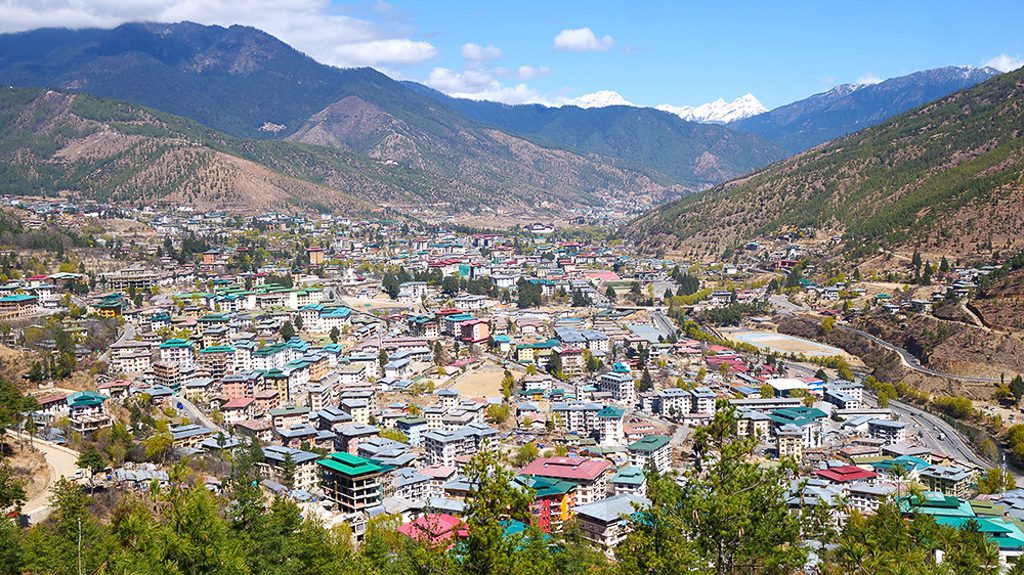
The Changlimithang sports ground in Thimphu was the site of a pivotal battle in 1885 that led to Bhutan’s first king controlling the entire country. Subsequent monarchs successfully reformed the country, bringing about peace. Reforms continued through the 1950s, when the decision to move the national capital from Punakha to Thimphu was made. The capital was then moved from the ancient capital of Punakha to Thimphu in 1961.

Prior to 1960, Thimphu was made up of several hamlets scattered around the valley that is now home to the modern-day city. I arrived in Thimphu with my guide Tsheten from MyBhutan in March of 2020, so I was there early enough to see snow on the surrounding peaks. Unlike Punakha and Paro, Thimphu was the first place I’d visited in Bhutan that was densely populated. It can be quite congested, but as it’s still a pretty small town, it only takes about 10 or 15 minutes to cross it. But there’s a lot packed into that small area, and it’s more than enough to provide several days of adventure. These are the 18 things to do in Thimphu!

Rising high above the city of Thimphu at the top of Kunzangphodrang mountain is the Buddha Dordenma. Located in a massive square in Kuenselphodrang Nature Park, this enormous statue is the largest sitting Buddha in the world at 177 feet tall. The gilded bronze statue was built between 2006 and 2015 to celebrate the 60th anniversary of Bhutan’s fourth king, Jigme Singye Wangchuk.
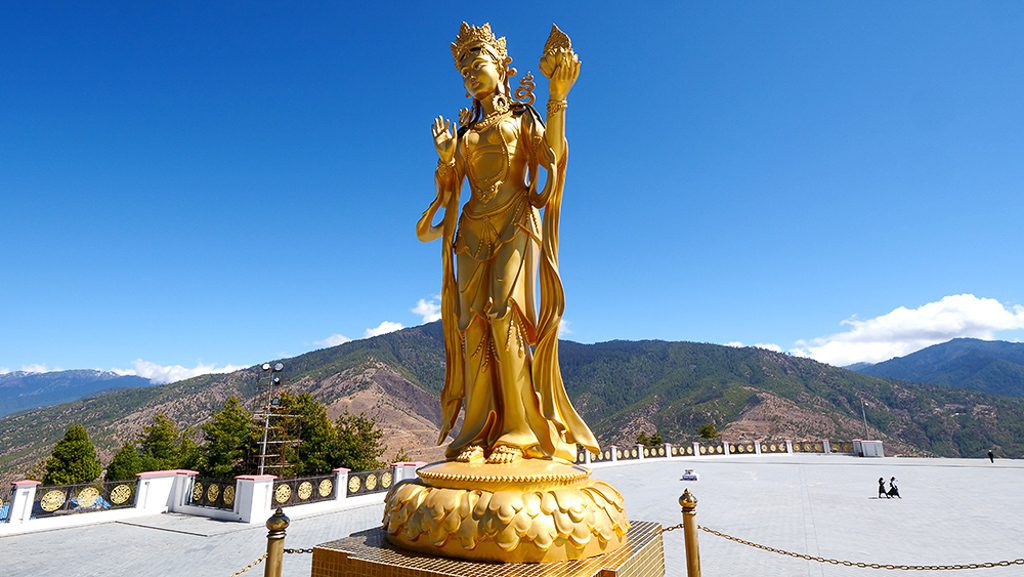
The statue’s construction also fulfilled a pair of prophecies made in the 8th and 12th centuries, which said that a giant Buddha statue would be built to bless the world with peace and happiness. I must say, visiting the Buddha Dordenma and standing in its shadow, it’s hard to not feel completely at peace. Maybe it’s because of what the statue represents, or perhaps it’s the beautiful setting among the mountains and forests above Thimphu, but it’s one of the most serene spots in the city.
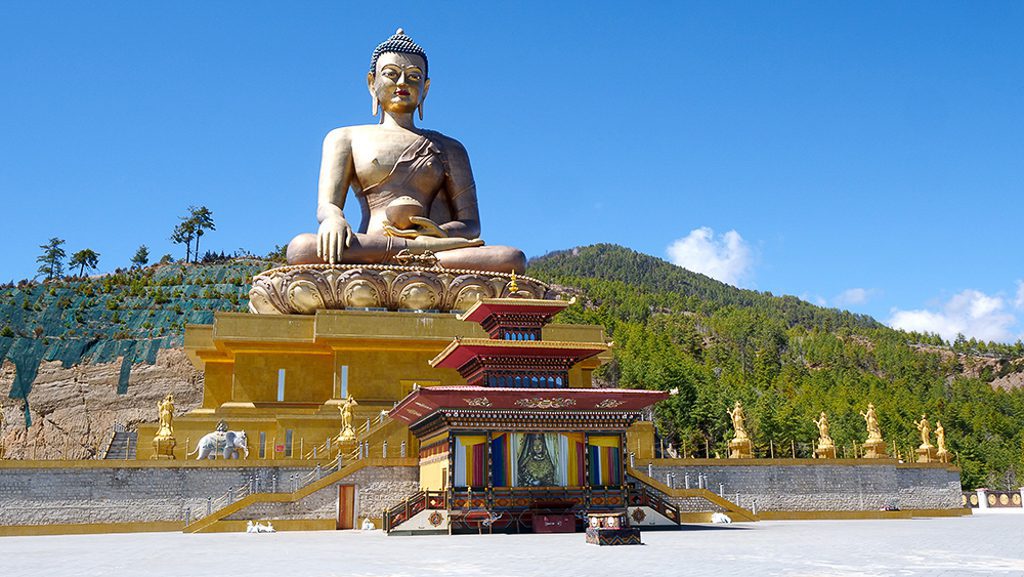
The statue isn’t just something to look at; you can also go inside it! Take note that you must remove your shoes and can’t film or take photos inside. Inside the statue, you’ll find 125,000 smaller Buddha statues. One hundred thousand of them are eight inches tall and the other 25,000 are 12 inches tall. It’s yet another of the reasons why it’s one of the best things to see and do in Thimphu, Bhutan!
Buddha Dordenma
Kuenselphodrang
Thimphu, Bhutan
PHONE: +975 77 85 71 41
HOURS: Open daily from 9 a.m. to 5 p.m.
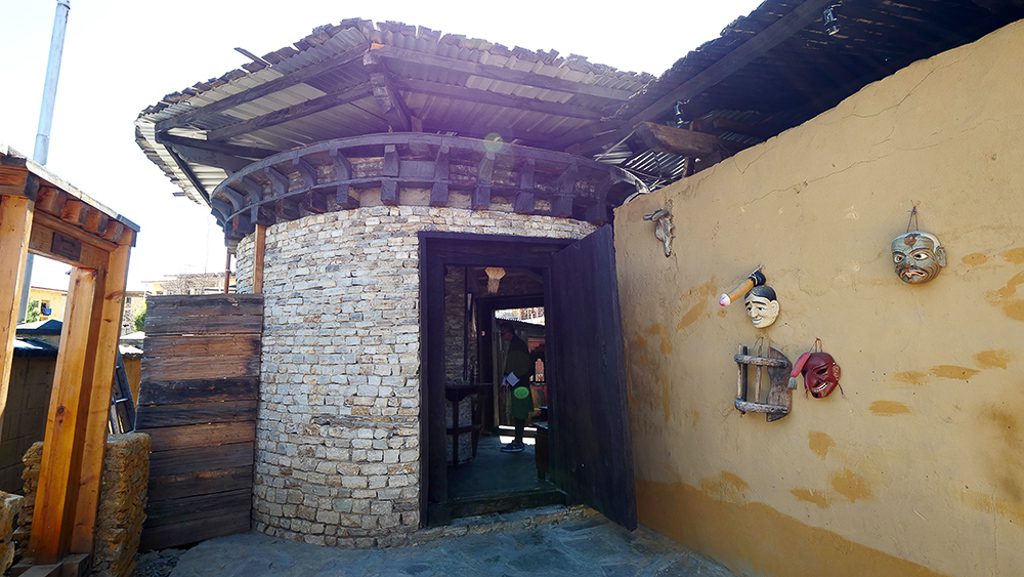
Travelers who don’t want to just learn about Bhutanese culture heritage but want to experience it for themselves, should take a visit to Simply Bhutan. This interactive, living museum is located in Thimphu’s Nazhoean Pelri Youth Center. It offers guests the opportunity to take a deep dive into traditional Bhutanese life. Best of all, it’s not very touristy, so it still has a very authentic feel.
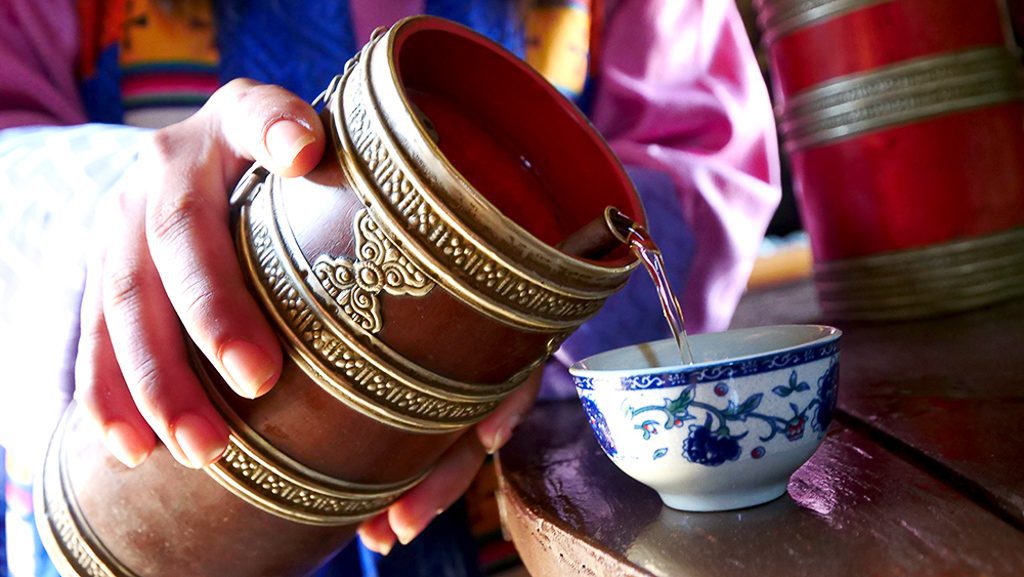
Upon entering the museum, guests will enjoy some smoky ara in the reception room. The walls of the room are lined with photos and information of each of Bhutan’s kings. As you continue through the museum, you’ll get to see how mud houses were built and witness a prayer song that is performed before houses are built.
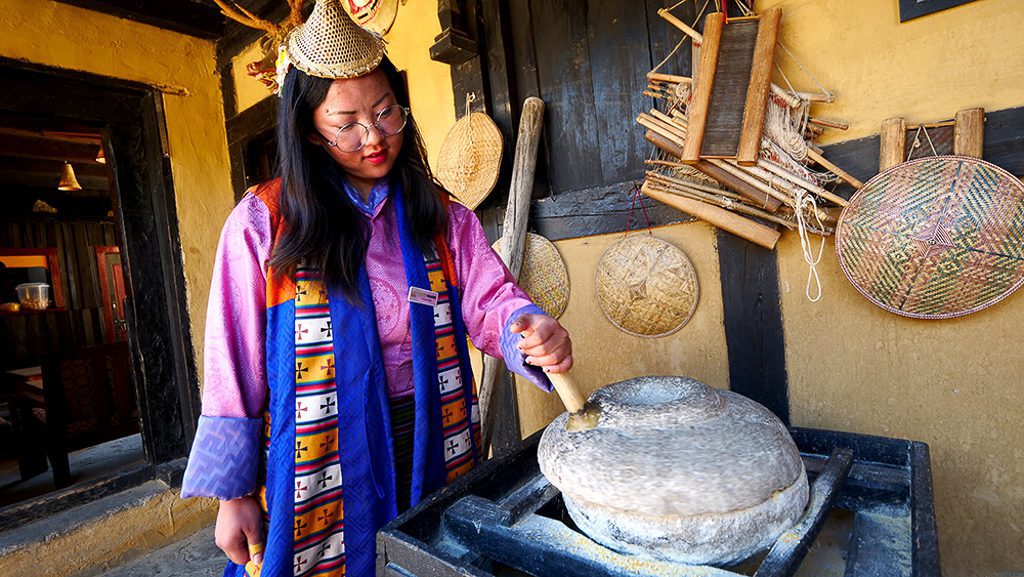
Further on, you can see an authentic rice flour milling system, a therapeutic stone bath, and a unique garden of phalluses. The phalluses, like the ones I had seen previously in the village of Sopsokha near Punakha, were different colors. They’re a sign of fertility and are also thought to deter and bring down evil forces.
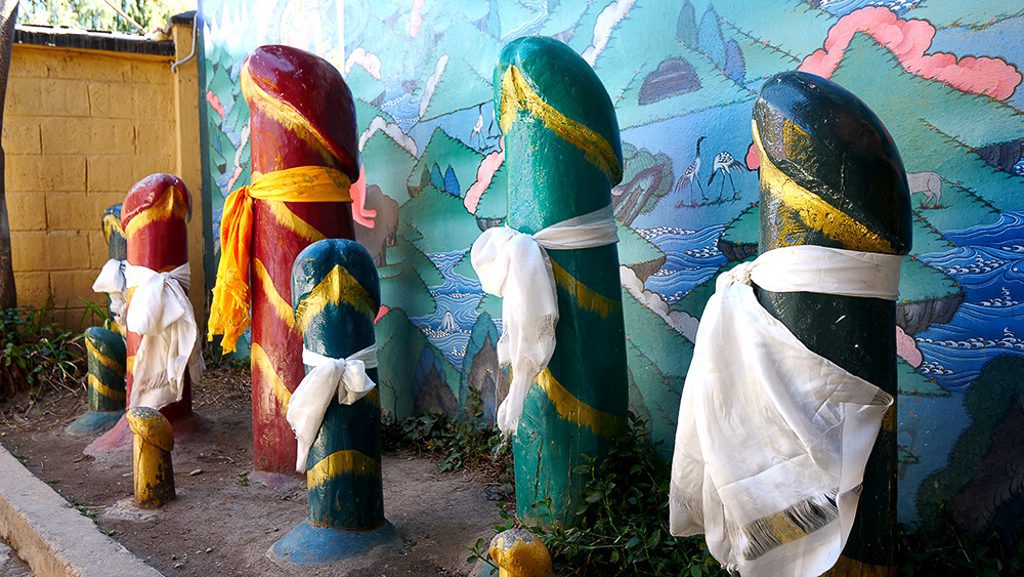
You can also see a traditional food storage system, which involves hanging strings of dried red chilies on the outer walls of a home. You’ll also visit an authentic kitchen and get the opportunity to buy a traditional gho (the national dress for Bhutanese men) at the gift shop. I also recommend trying your hand at archery at the targets outside. If you hit the target, the people there will do a celebratory dance!
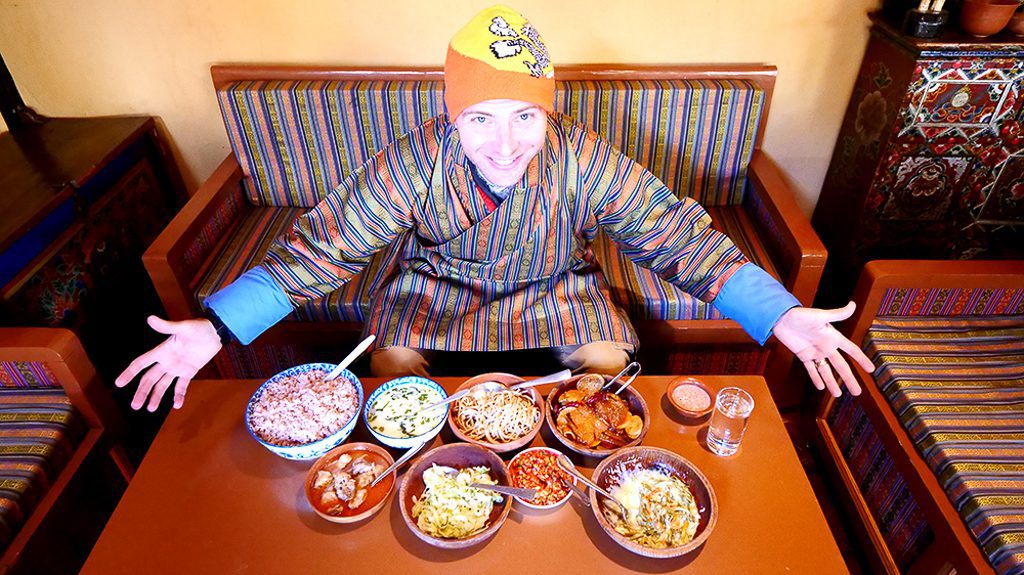
One of the highlights of Simply Bhutan is their restaurant, where you can try typical Bhutanese dishes prepared by local chefs. While I’m not a huge fan of the suja, or butter tea, I can easily recommend the creamy and spicy ema dashti (chilies with cheese), fresh cabbage salad with ezay (chili salsa), and the chicken and buckwheat noodles. Mix the ema dashti and the buckwheat noodles to make a silky, rich, and spicy pasta dish! Having this meal is easily one of the best things to see and do in Thimphu, Bhutan!
Simply Bhutan
Genyen Lam
Thimphu, Bhutan
PHONE: +975 2 323 897
HOURS: Open daily from 9 a.m. to 5 p.m.
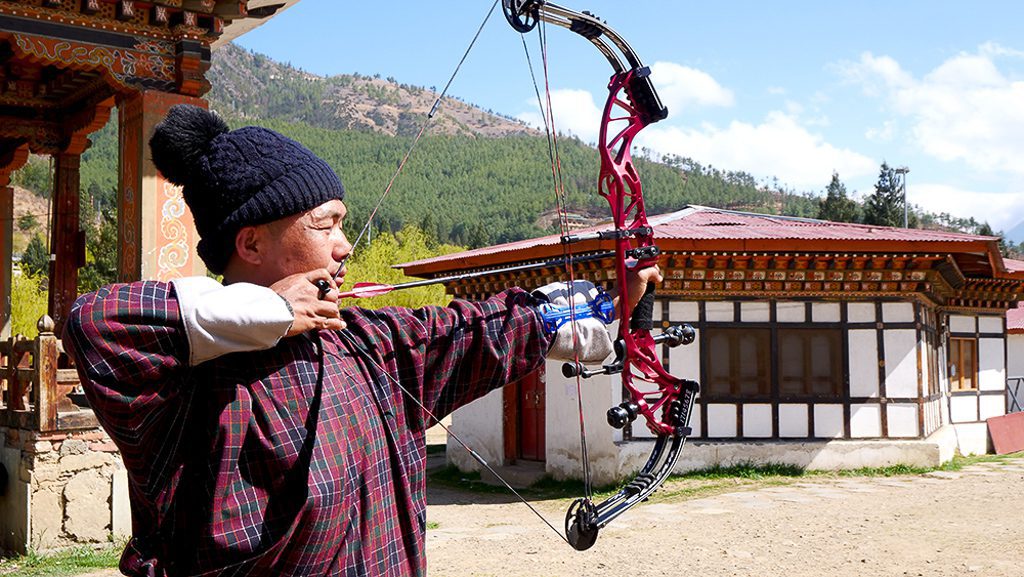
After you’ve gotten to try your hand at archery at Simply Bhutan, head over to the Changlimithang Archery Ground. Located in the heart of the city just south of Changlimithang Stadium, this is the best place in Thimphu to observe professional archers doing what they do best!
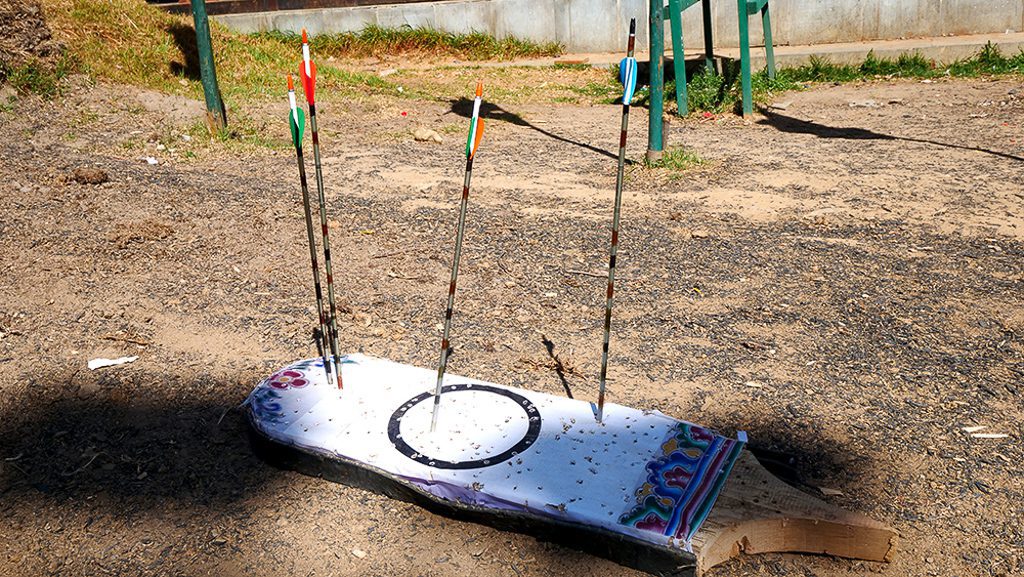
This is where professional archers hone their skills. Unlike Olympic archers, who shoot from 70 meters away in outdoor competitions, these incredible archers double that distance to 140 meters!
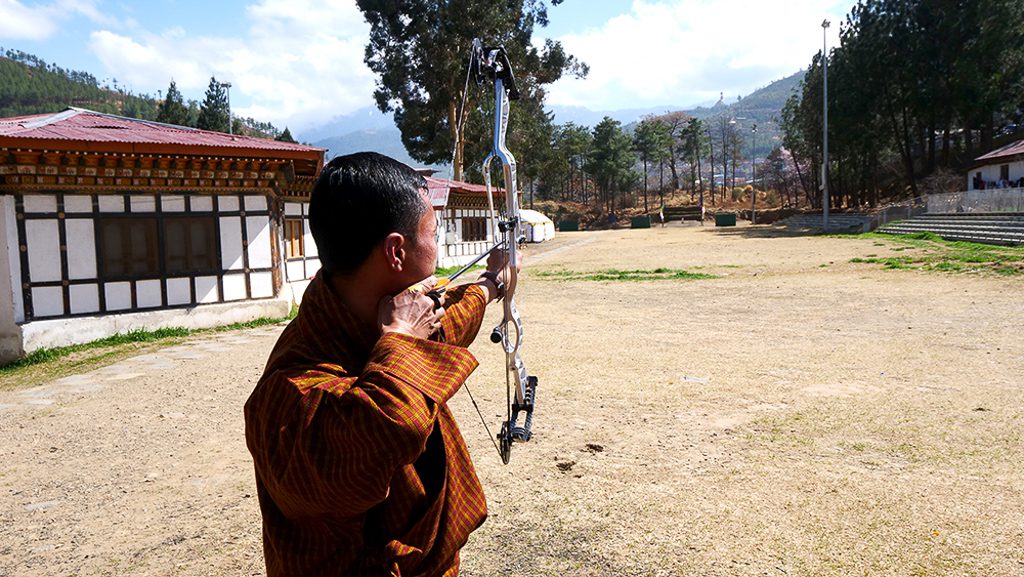
While non-professionals can’t practice here, you can spend a few minutes watching the pros. During my visit, I watched a sharpshooter hit the target from afar. Then, I got a better look by crouching behind a wall close to the target, where several more arrows hit the bullseye! I couldn’t believe that they could hit the target from that far away and do it consistently. If you want to have your mind blown, it’s one of the top things you must see and do in Thimphu, Bhutan!
Changlimithang Archery Ground
Chang Lam
Thimphu, Bhutan
Hours: Saturday and Sunday; 7:30 a.m. to 11 a.m.
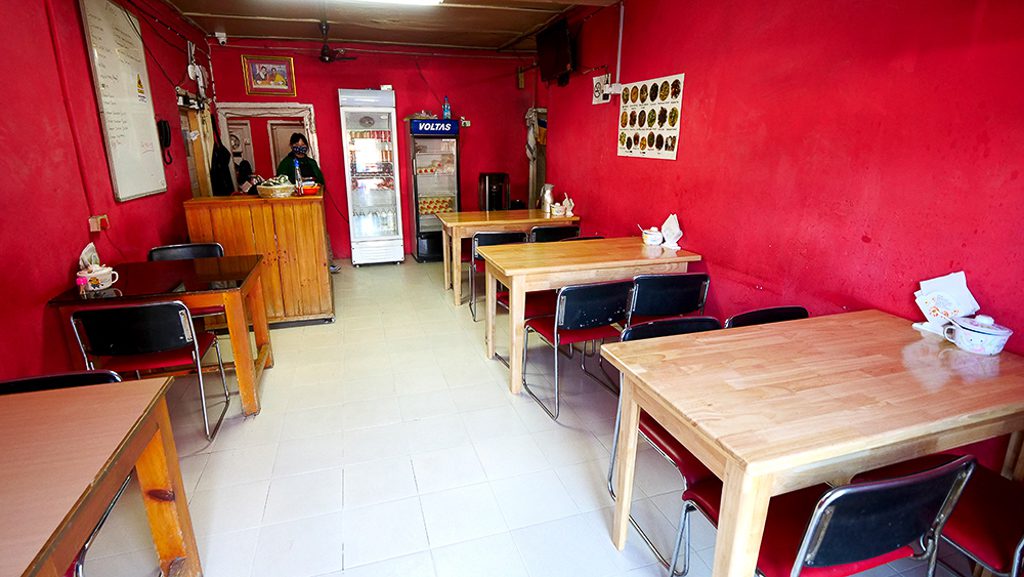
When you’re in the mood for traditional Bhutanese cuisine in Thimphu, the best place to go is Kalden Restaurant. It’s among the top things to see and do in Thimphu, Bhutan because it’s the only restaurant in Thimphu that sells traditional food.
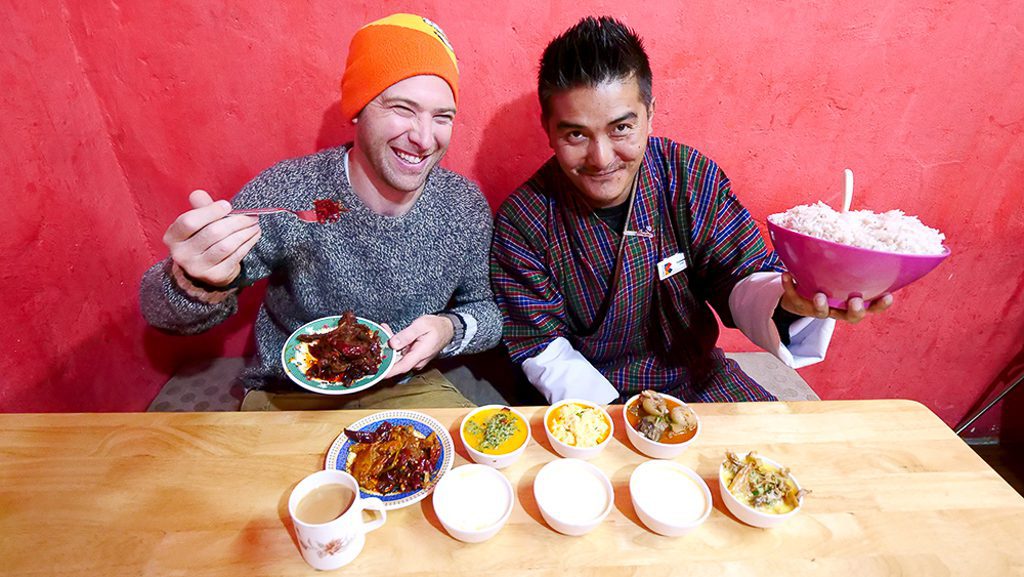
If you’d like to dine with other patrons, there is a main dining hall, but if you prefer some privacy, there are two private dining rooms in the back. Wherever you choose to eat, I recommend going all-out and trying their spareribs, spinach and cheese, red rice, white chilies and cheese, cheese and egg butter fry, spinach soup, tripe, and pigs feet.
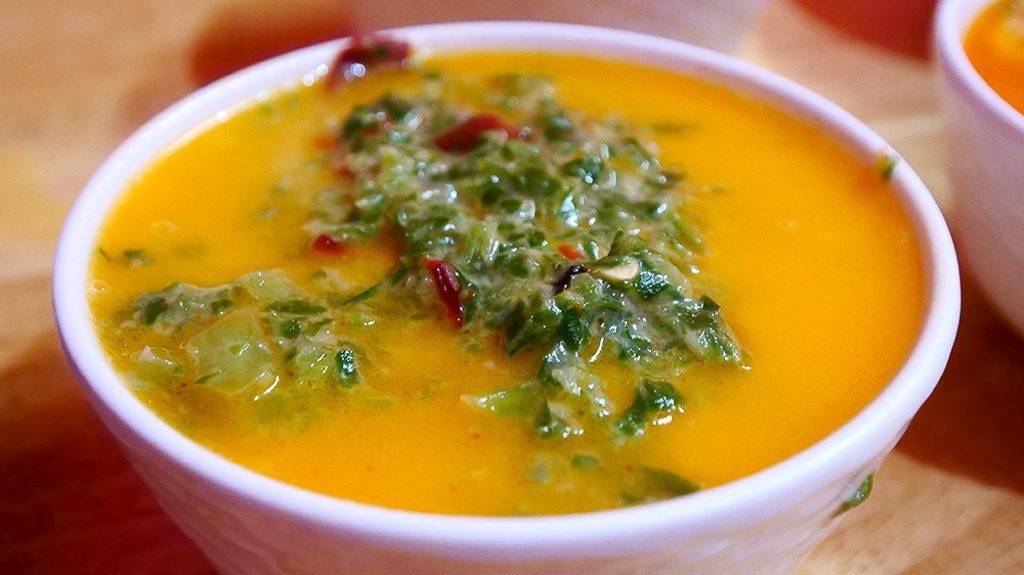
Be forewarned that everything on the menu is spicy. I particularly loved the flavorful and spongy tripe, which contained Szechwan peppers that numbed my mouth and added a fair bit of heat! The white chilies with cheese were meaty, almost like mushrooms, while the spinach soup was light and creamy. Meanwhile, the eggs were like a cheese overload! They were so cheesy I couldn’t taste the butter at all.
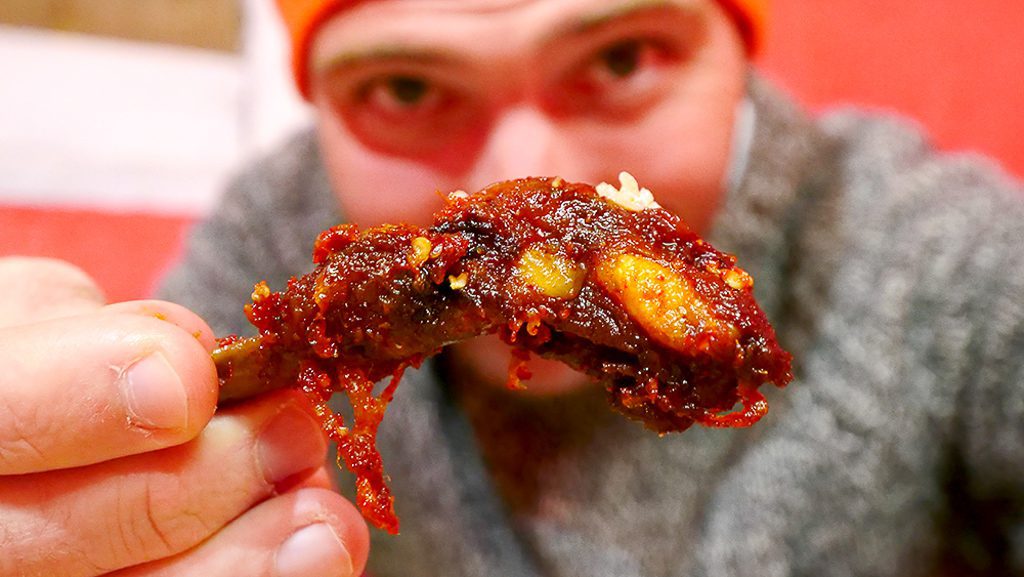
Another highlight of the meal were the pig feet, which were gelatinous and full of flavor. You also can’t miss the spareribs, which were drenched in a hot, glazy sauce that reminded me of a Chinese sauce I’d had before. If the heat gets too bad, try pairing the dishes with the red rice, which helps temper the heat a bit.
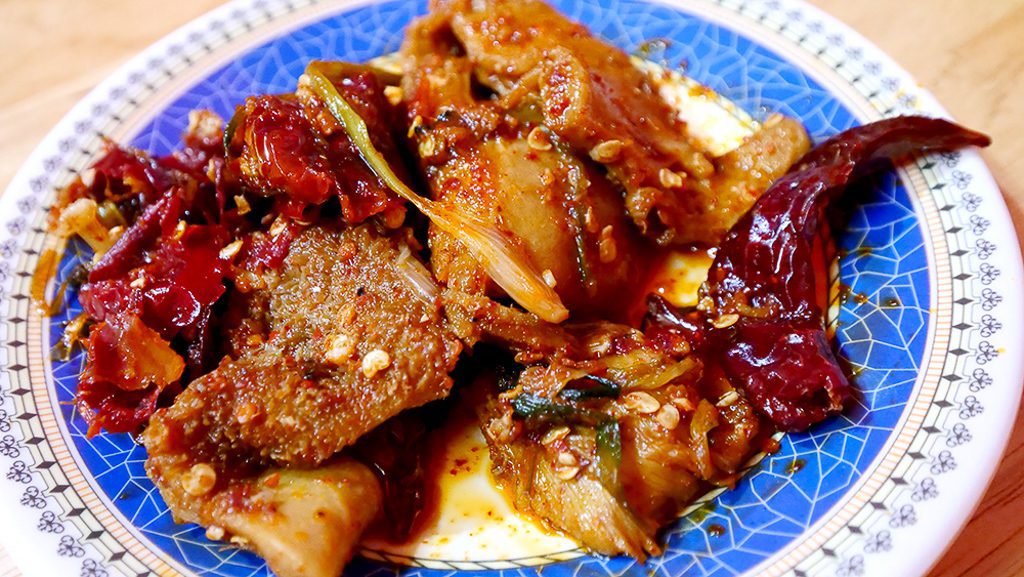
All in all, it’s one of my favorite meals I ate in Thimphu. Try them all if you can, but if you can’t, at least order the tripe. It’s a delicious, spicy, iron-rich organ meat and was so tasty I got a second order of it!
Kalden Restaurant
Chang Lam Road
Thimphu, Bhutan
Phone: +975 17 66 75 76
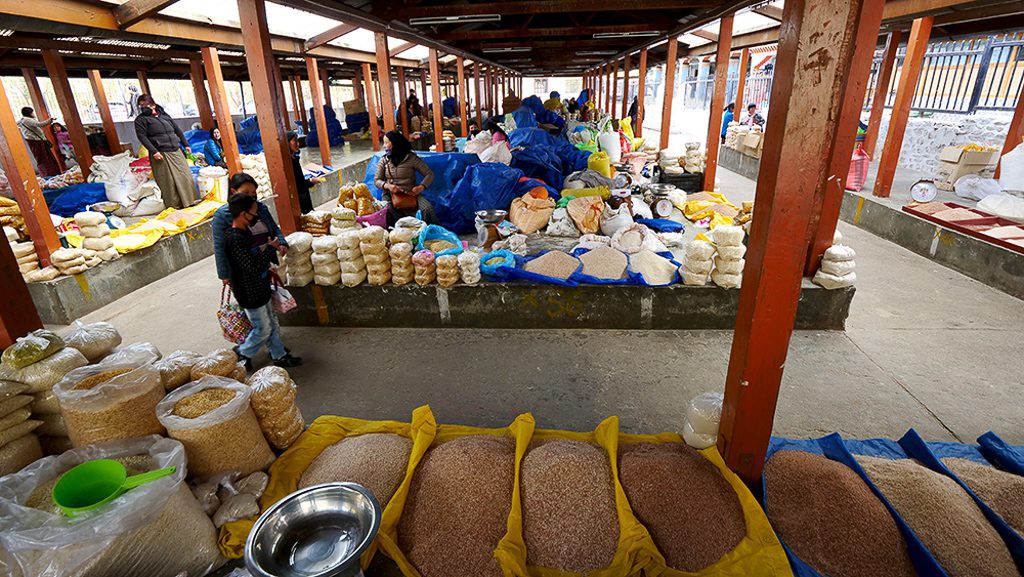
Another way to get a real feel for daily life in Thimphu is to visit Centenary Farmers’ Market just north of Changlimithang Stadium. Centenary Farmers’ Market is a weekend market where you can find fresh produce, dried fish, cereals, street food, incense, and much more. Vendors from all over the area arrive in Thimphu on Thursdays and Fridays and stay throughout the weekend to sell their goods.

I visited on a Sunday as the market was dying down for the weekend, so there weren’t many patrons. Most of the farmers had already packed up and left, so if you want to see the market in full swing, I advise visiting on Friday or Saturday. That said, I was still able to see nearly 200 vendors selling red rice, dried corn, tomatoes, chilies, carrots, onions, potatoes, lettuce, bamboo, mushrooms, eggplant, spinach, and much more. I learned that most of the vegetables came from India.
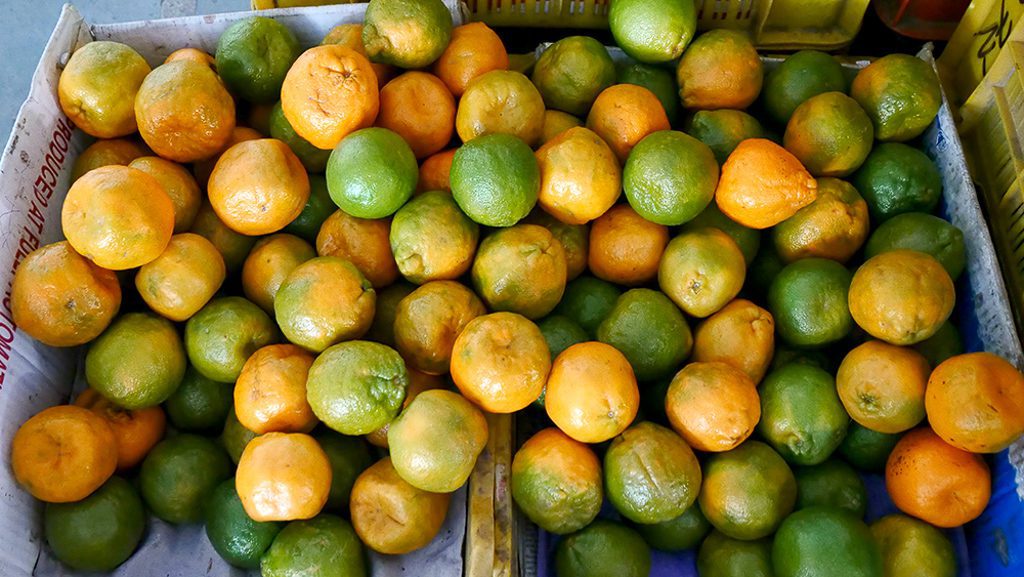
There’s also a fruit section, but only the apples, papaya, bananas, sugarcane, and mandarins were grown in Bhutan. One thing you may notice during your time in the country is that the Bhutanese people tend to prefer vegetables to fruits and desserts. I was able to find a bag of dried apple for 30 Nu/$0.40 USD.

Don’t miss the upstairs area, where you’ll find more produce, as well as ginger, beans, and the cow cheese that’s used to make ema dashti. There’s also a section for farmers that sells tools like rakes, knives, and axes. In the Local Farm Produce Section, you can buy a wide variety of dried chilies, dried turnip leaves, dried pumpkin, and even local honey.
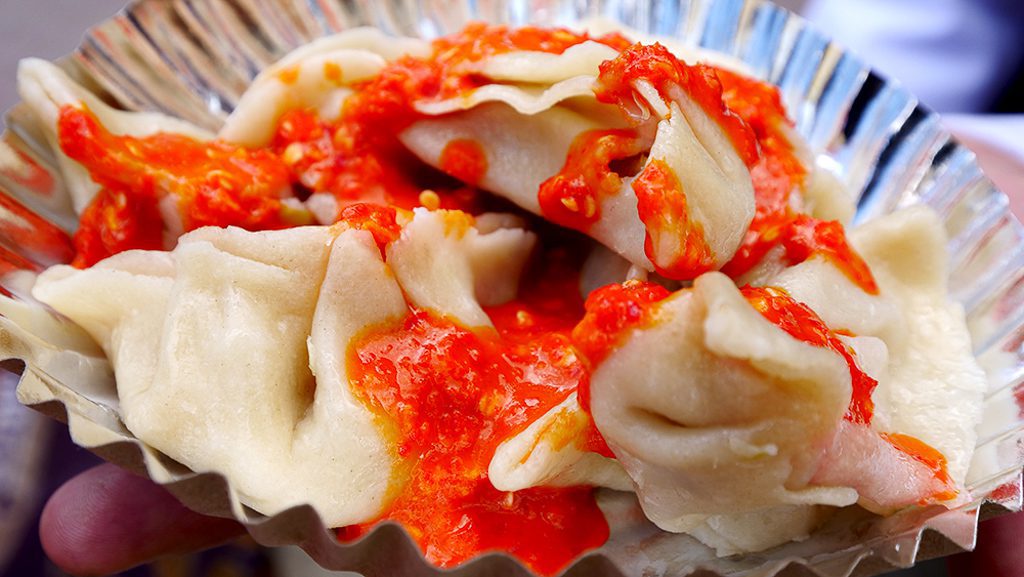
Unlike its neighbor to the south, India, Bhutan isn’t big on street food. But I managed to find some delicious vegetarian momos sold by a vendor at Centenary Farmers’ Market. They contained flavorful and crunchy cabbage and were doused in a chili sauce that wasn’t very spicy but had my mouth watering!
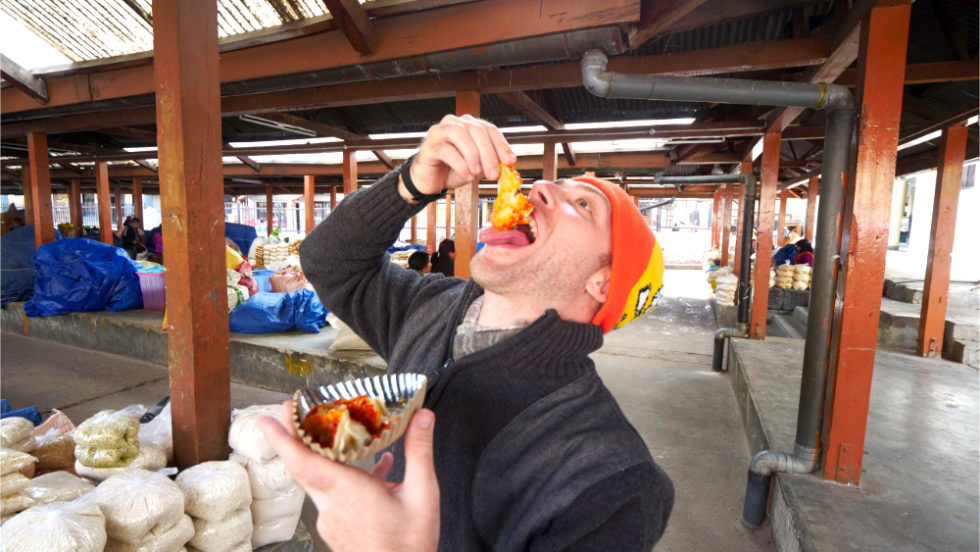
You can buy a generous helping of these momos for just 40 Nu/$0.53 USD. They were the highlight of my market visit and one of the best street food dishes I triedand is one of my top things to see and do in Thimphu, Bhutan.
Centenary Farmers Market
Lower Market
Thimphu, Bhutan 11001
Phone: +975 02 337465
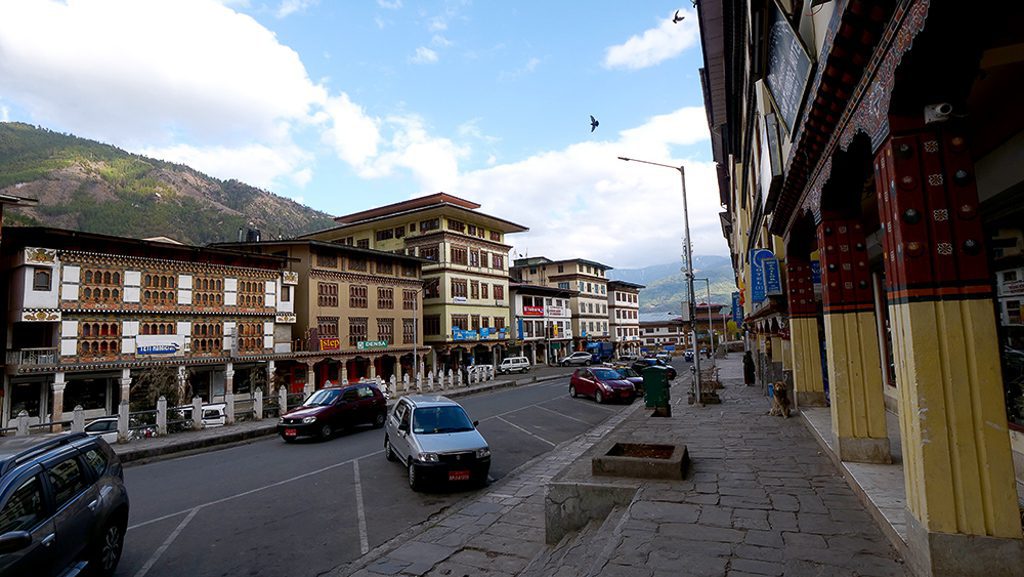
One of the great things about Thimphu is that everything in town is within ten or fifteen minutes of each other. This is a stark contrast from Punakha, where the city is more spread-out and many of the points of interest are 30 or more minutes from each other. The larger but more compact Thimphu makes it easy to explore, and one of the best spots to check out is the downtown area.

The downtown area is a quaint area with lots of traditional architecture. It reminded me of a town I’d visited in the Pyrenees mountain range in Andorra years prior. It was much older than Thimphu, but the two cities had the same relaxed, alpine feel.
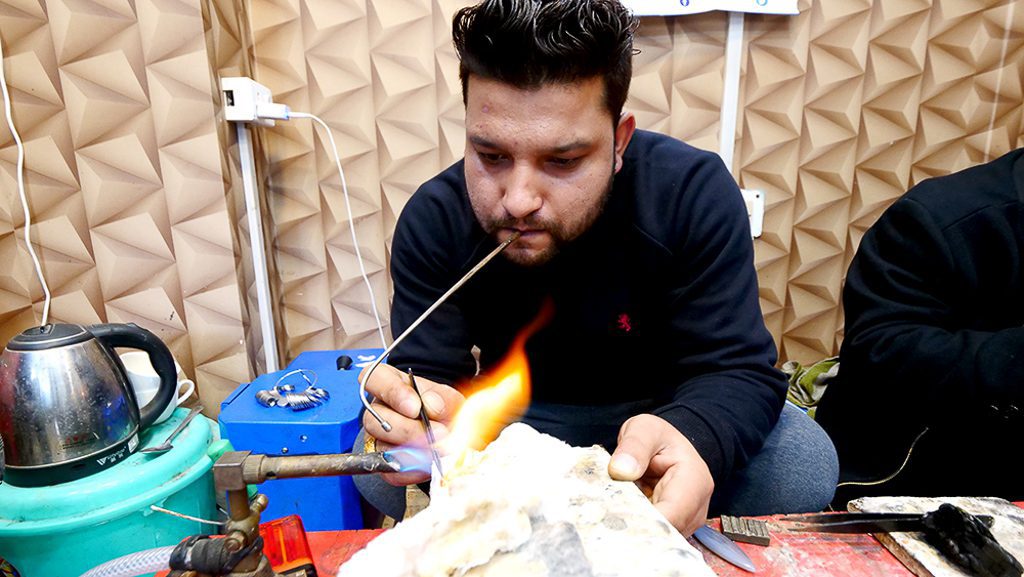
Most of the buildings in the downtown area are more or less the same. They’re mostly three stories, with shops on the bottom floor; restaurants, bars, and other businesses on the second floor; and residential space on the top floor. Among the businesses you’ll come across are beauty salons, jewelry shops, hotels, and souvenir shops.
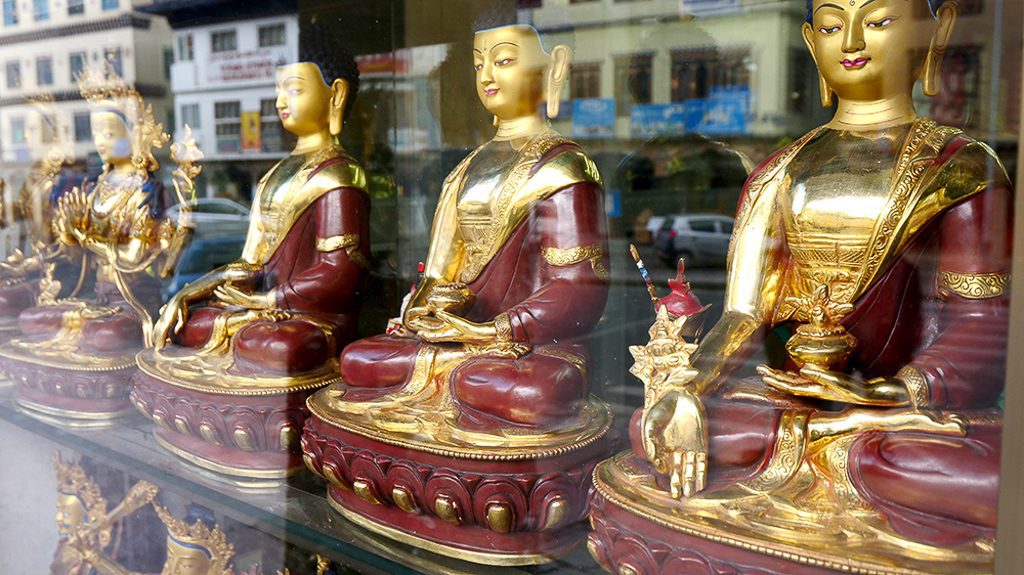
One of my favorite souvenir shops in town is Yeti Handicraft. Thimphu was extremely chilly the first day I visited, so I stopped inside to buy a traditional wool scarf. It cost me 950 Nu, or about $12.52 USD. You can also find tea sets, teacup covers, and my favorites, large, traditional Bhutanese masks there!
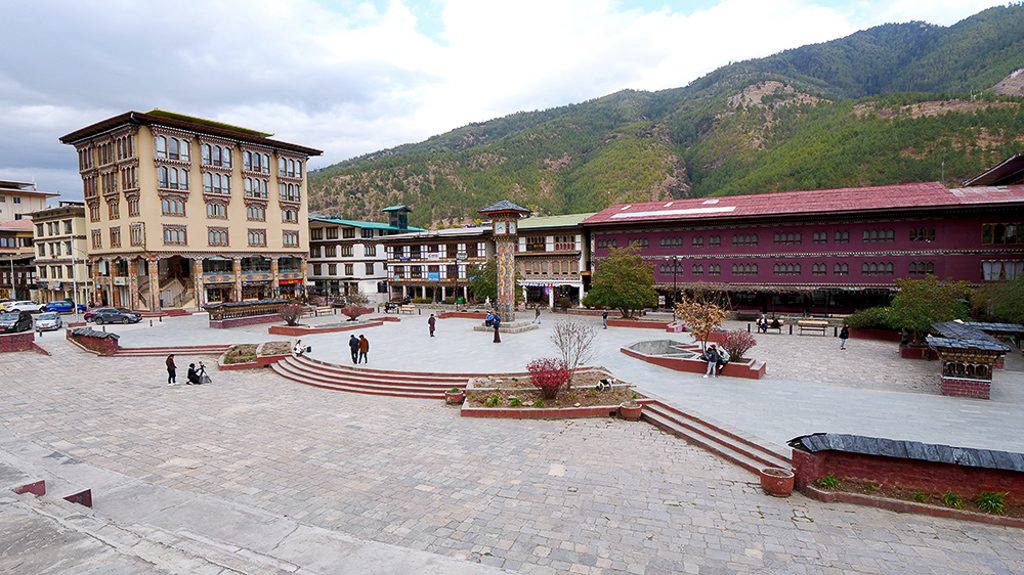
The downtown area is also home to the city’s main square, which hosts celebrations. It’s quite large and is bounded by a clocktower, hotels, and other businesses. Even though it’s in the middle of the largest city in the country, the square was actually quiet and a peaceful place to visit. On the day I visited, there was a film crew filming a commercial for hand sanitizer there!

One interesting fact about Thimphu is that, even though it’s the largest city in the country, there are no traffic lights. Instead, traffic is directed by a police officer in a booth that stands in the middle of the road. There aren’t many cars out on the road in the city, and it seemed like everyone obeyed the officer in the booth. It was a fascinating aspect of the city and one of the things you must see and do in Thimphu, Bhutan!
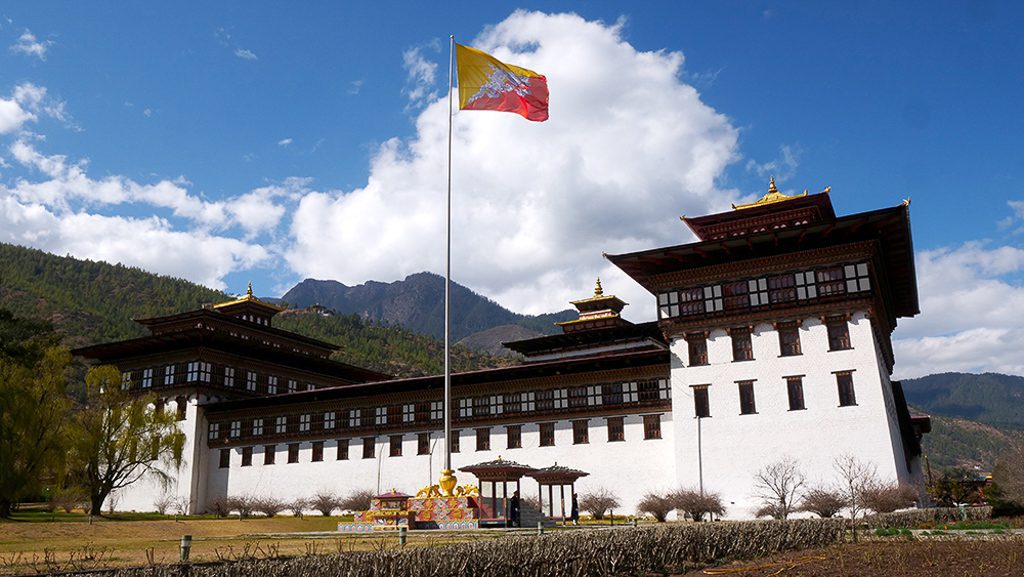
Another of Thimphu’s top attractions is the 17th-century fortress and monastery called Tashiccho Dzong. Every district in Bhutan has a dzong that serves as its political, religious, and royal headquarters, and Taschiccho Dzong is the one for the Thimphu District. It’s one of the things you must see and do in Thimphu, Bhutan, for sure!
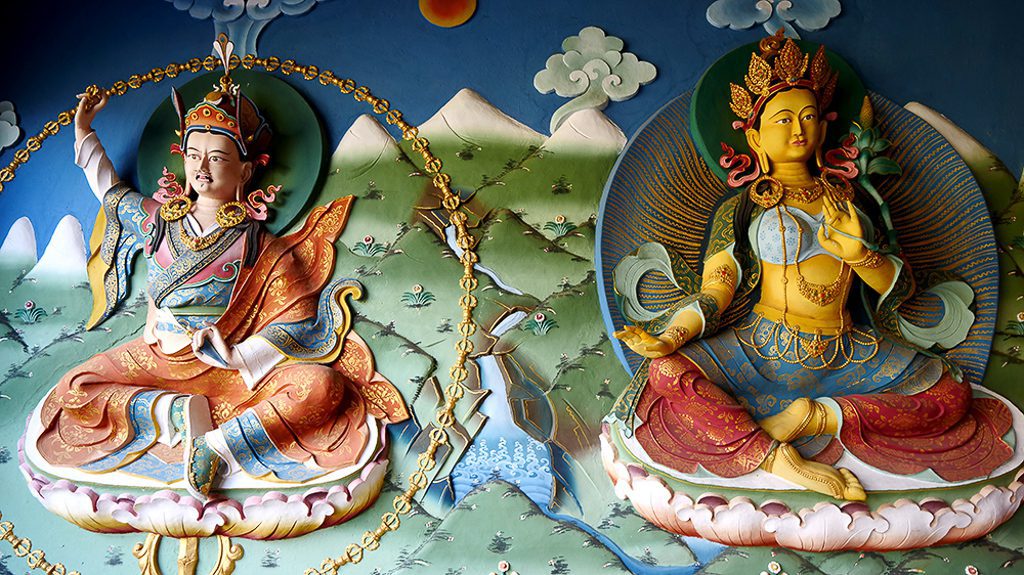
Taschiccho Dzong’s history dates back to the 13th century, when nearby Do Ngon Dzong was built. In the 17th century, when the unifier Ngawang Namgyal took over the fortress, renamed it Taschiccho Dzong, and made it his monastic and civil center. It was too small to accommodate everything he needed, so he built the a much larger Taschiccho Dzong at a lower elevation. The present-day dzong has undergone many modifications since, including an enlargement after the capital was moved to Thimphu in the 1960s. Over the years, the dzong has withstood fires and earthquakes.

The fortress is massive and very colorful. I loved admiring the beautiful architecture, which gives off a tremendous sense of peace. There’s a huge flag out front, and two royal guards stand below it. Inside, after you go through metal detectors and submit to a search of your bags, you’ll find stunning paints of dragons, gods, and other figures on the walls.

The dzong is divided into a religious section and an administrative section. Visitors can only visit the religious area. There, you’ll find a large courtyard where they used to host the festival that now takes place at the dzong in Punakha. You’ll also find a temple and over a dozen monasteries. The monastery exteriors have depictions of elephants, tigers, snow leopards, and the god Garuda painted on them. If you’re lucky, you may get to witness monks chanting inside the temple, which is home to statues of the Buddha, the unifier, and the second Buddha.
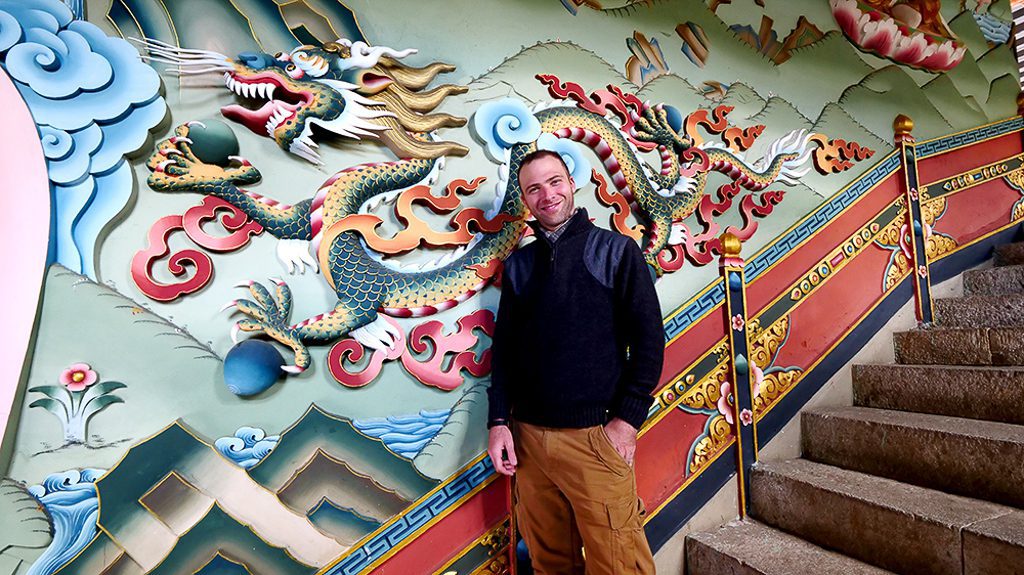
NOTE: If you choose to wear a gho to Tasiccho Dzong like I wanted to, keep in mind that the way you wear it has to be 100% traditionally accurate. If it isn’t, you can’t wear it on the grounds. Also note that you cannot film or take photos inside the temple.
Tashichoo Dzong
Chhagchhen Lam
Thimphu, Bhutan
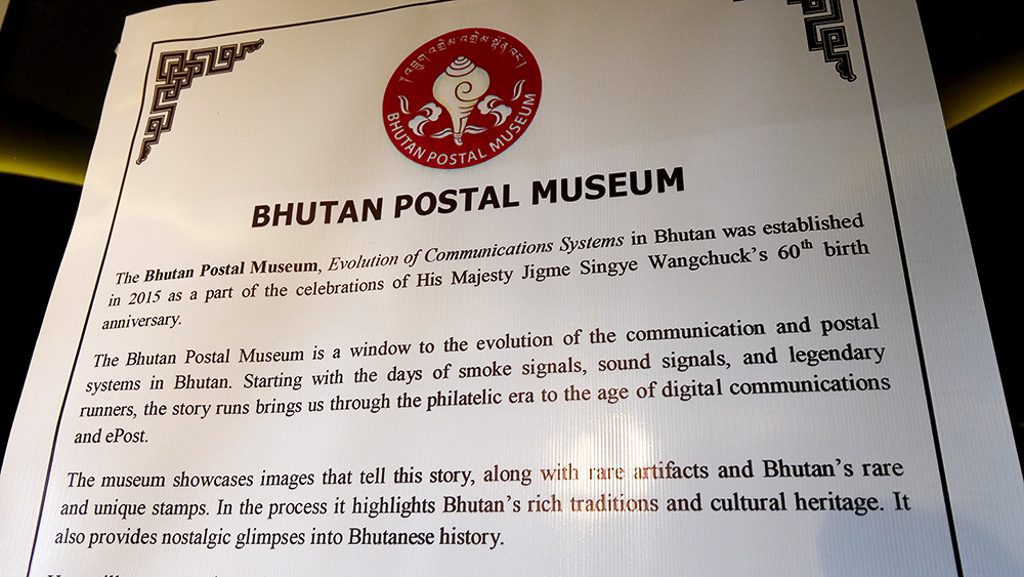
Not far from Changlam Square and the Thimphu Plaza shopping center is the Bhutan Post Office Headquarters. Usually, a post office—or its headquarters—wouldn’t really be of much interest to many travelers, but this is one major exception. The traditional building, which also houses the Bhutan Postal Museum and a bakery, is definitely among the things to see and do in Thimphu, Bhutan.

Inside the Bhutan Post Office Headquarters, you can view the world’s largest photo book and take in their extensive collection of ancient stamps. You can also visit their five galleries, one of which is a media room where you can watch a documentary about the people who delivered mail in Bhutan’s early days.

But the real highlight of the Bhutan Post Office Headquarters is the fact that it’s the only post office in the world where you can print a real stamp using an image from your phone. For $500 Nu/$6.67 USD, you can buy a sheet of 12 stamps, and for another 30 Nu/$0.40 USD, you can buy a postcard. I bought two sheets of stamps with an image of my daughters on them and mailed postcards to them and my wife using them. It takes about two weeks for mailed postcards to get to their destination. They’re priceless souvenirs that my family will have forever!
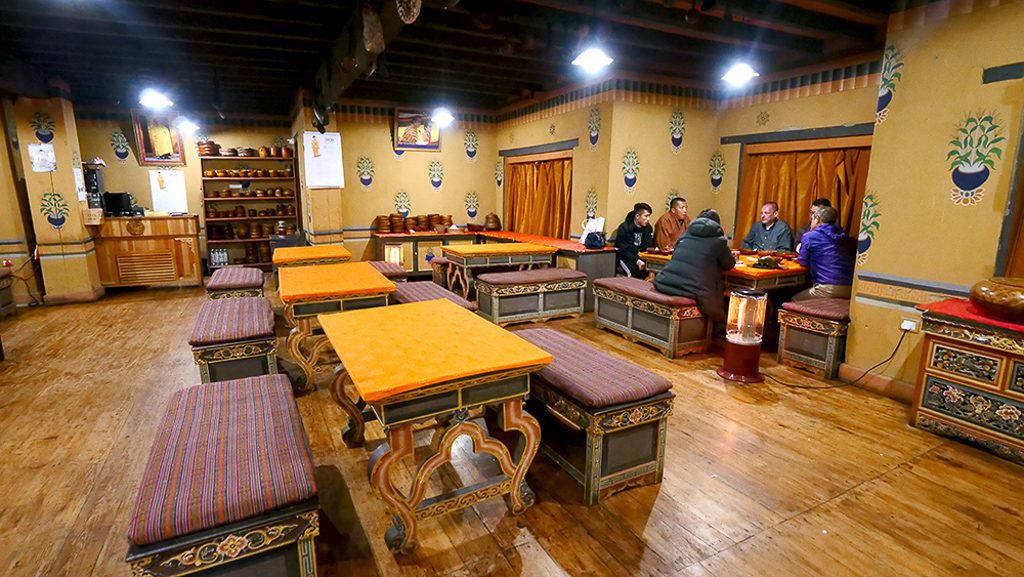
If you’re in the mood for traditional Bhutanese folk food, head over to the Folk Heritage Museum Restaurant. Inside the cozy, rustic space, you can try some insanely spicy dishes along with suja (butter tea) and ara (rice wine). If you’d like, you can also enjoy your meal in their outdoor seating.
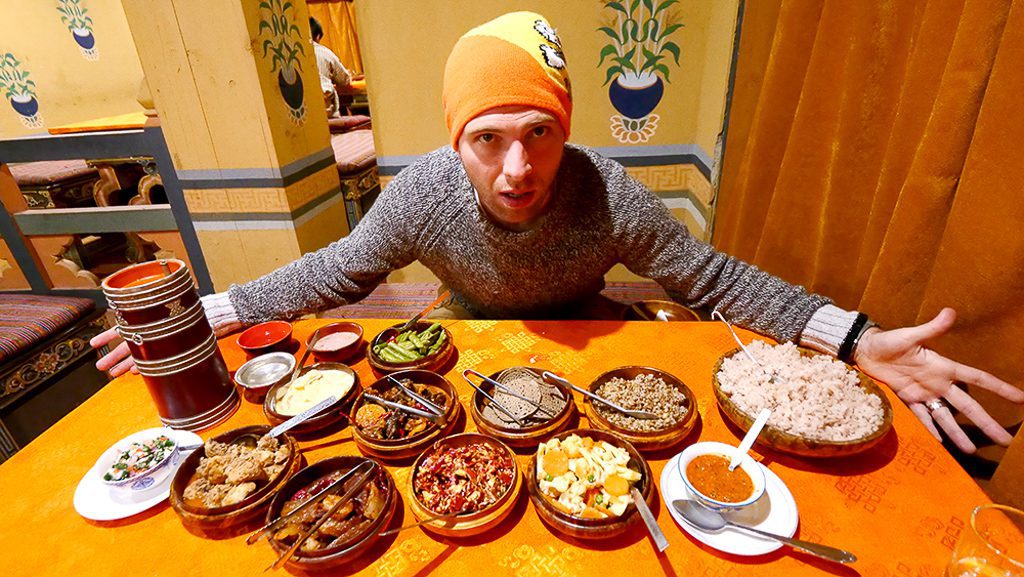
I recommend trying the fatty pig’s feet, the crunchy and refreshing cucumber salad with cow cheese, a light mushroom broth, and the cabbage-stuffed momos as your starters. Try each with the ezay, which is a fiery salsa made from red chilies. If it gets too hot for you, try either the suja with puffed rice or the ara to temper the heat.

For your main course, go all-out with ema dashti, dried pork, mixed vegetables, buckwheat pancakes, dried beef with radish, French beans, and kewa dashti (potatoes with chilies and cheese). The cheese melted throughout the ema dashti is incredible, and the cheezy kewa dashti was like a flaming hot potato salad. Try the buckwheat noodles with chili salsa, and I also recommend the dense, jerky-like dried beef.

Of all of the meals I had in Thimphu, this one was my favorite. The heat combined with the contrasting textures and complexity of flavors made this a fantastic food experience. It’s another of the things you must see and do in Thimphu when you visit!
The Phelchey Toenkhyim (Folk Heritage Museum)
Kawajangsa, above the National Library of Bhutan.
Thimphu, Bhutan
PHONE: +975 02 327133

During your time in Thimphu, you’ll need a comfortable spot to keep your possessions and lay your head at night. The best place for that is the Pedling Hotel & Spa, located in the heart of downtown Thimphu. The hotel boasts 33 rooms, including 27 standard rooms, three deluxe rooms, and three executive suites. They also offer free WiFi, laundry and concierge services, airport transportation, sightseeing tours, car rentals, an on-call doctor, and more.

I stayed in one of the standard rooms on the second floor, which are furnished with two twin beds, a wardrobe, a pair of low tables (one loaded with water, cups, coffee, and tea), a small workstation, a small fridge, and a TV. The bathroom is nice and spacious, and the accommodations overall are very comfortable.
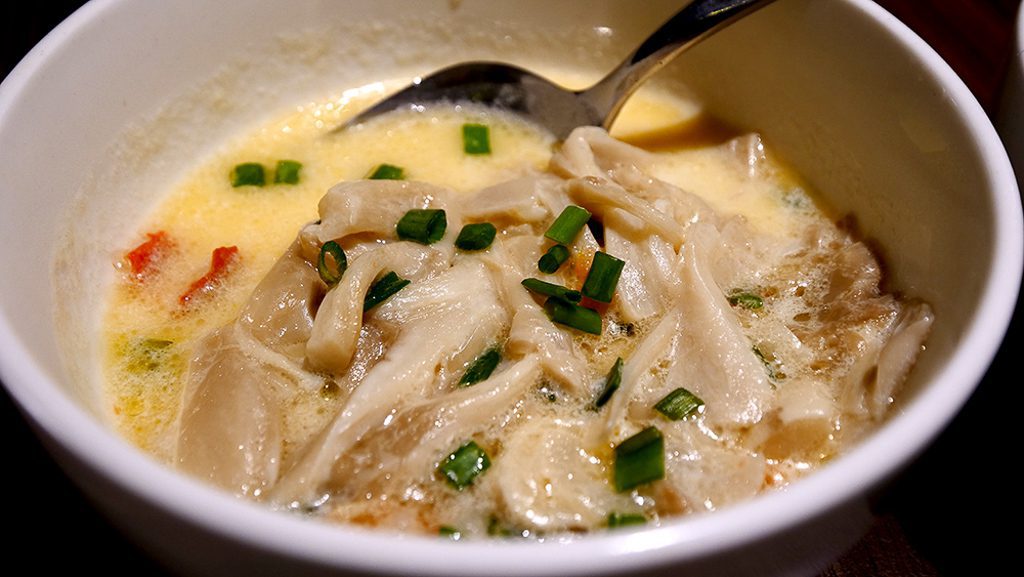
For dinner, I recommend heading down to the Pedling Hotel & Spa’s restaurant, which offers multiple cuisines, a la carte dining, and set menus. I suggest sticking with Bhutanese cuisine to continue to immerse yourself in the culture. They also have local wines, beers, brandy, and whiskey on the menu, so if you’d like to indulge, you have plenty of options!
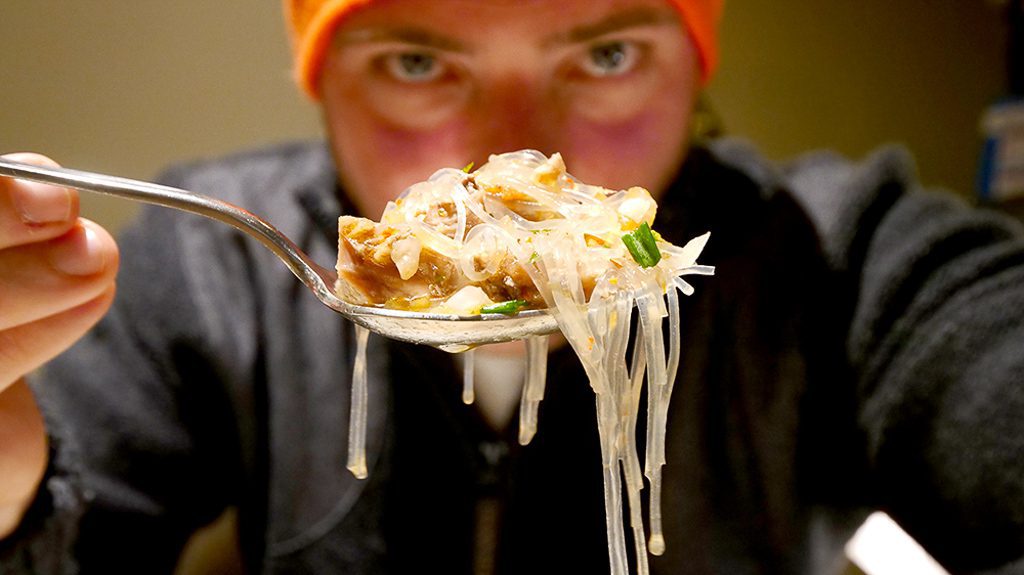
I enjoyed a Bhutanese dark ale called Red Rice along with a small but filling dinner. I can’t recommend their creamy and cheesy mushroom curry with spring onions enough. Another great option is the tender and juicy beef with delicate glass noodles and spring onions. Enjoy both with a side of red rice!
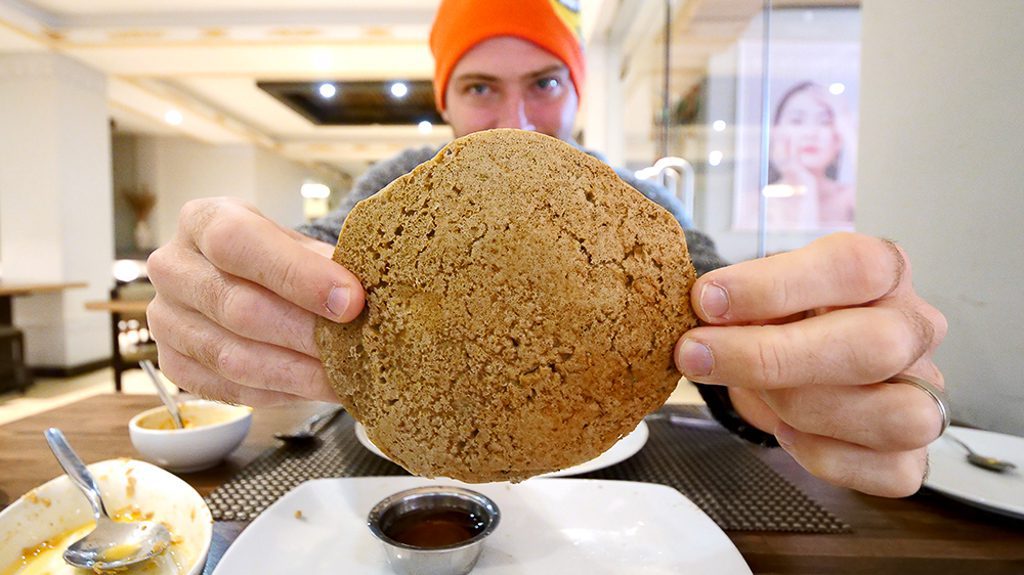
You can head down to the same restaurant in the morning to enjoy a simple but tasty central Bhutanese breakfast. Central Bhutan grows lots of buckwheat, which the people use to make noodles and pancakes. I suggest starting your day with some pancakes!

Buckwheat can have a slightly bitter flavor, so instead of eating them plain or with the provided butter, I suggest trying them with honey. It cuts the bitterness and balances the earthiness of the buckwheat and the buttery flavor on the outside of the pancake.

The pancakes are still fluffy, but they’re also a bit doughier than a typical American pancake. They’re still quite good, though! Having them is the perfect way to carbo-load if you’re planning on going for a hike later in the morning!
Pedling Hotel & Spa
Dondrum Lam
Near Swiss Bakery, Above Main Traffic, Opposite Zimdra Showroom
Thimphu, Bhutan 11001
PHONE: +975 2 325 714
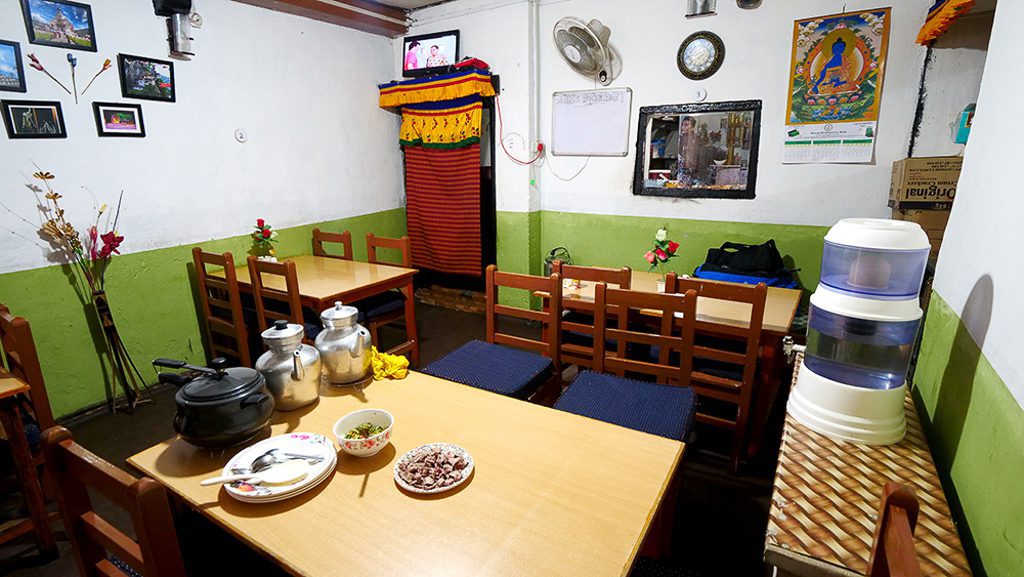
If you’re staying at the Pedling Hotel & Spa and would like to venture out a bit for breakfast, take a three-minute walk to Typical Bhutanese Restro & Bar. It’s a small, cozy restaurant located in Hong Kong Market in the center of the city. There are only four tables inside, along with a small bar area that sells local beer, brandy, and whiskey.
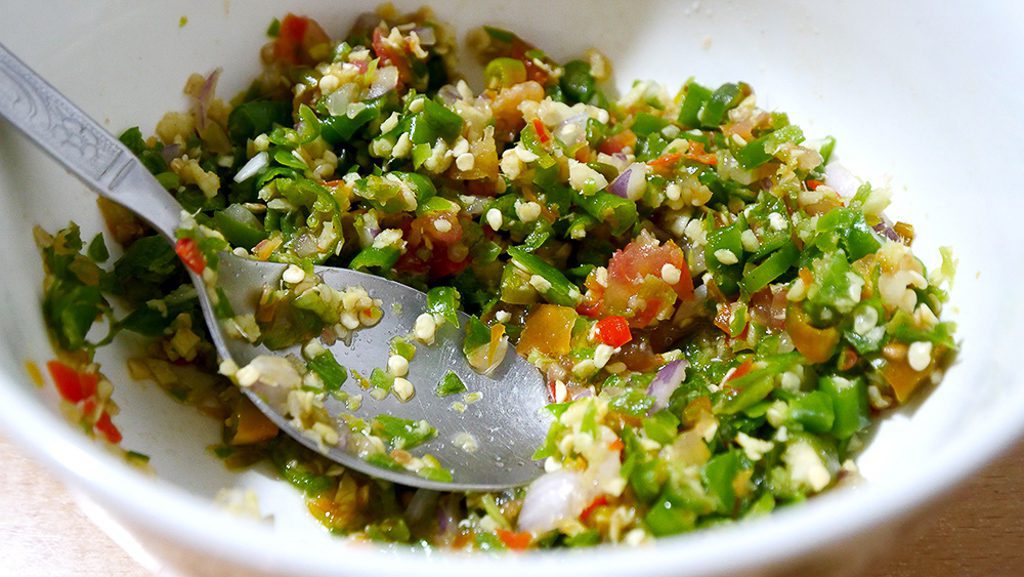
For breakfast, I suggest going with some dried beef, scrambled eggs, rice, and ezay. The dried beef is a bit like jerky and can be pretty tough, but it’s so flavorful that it’s worth chewing through. The trick is to let it sit in your mouth for a while to let your saliva soften it up. The eggs are good but a bit oily.
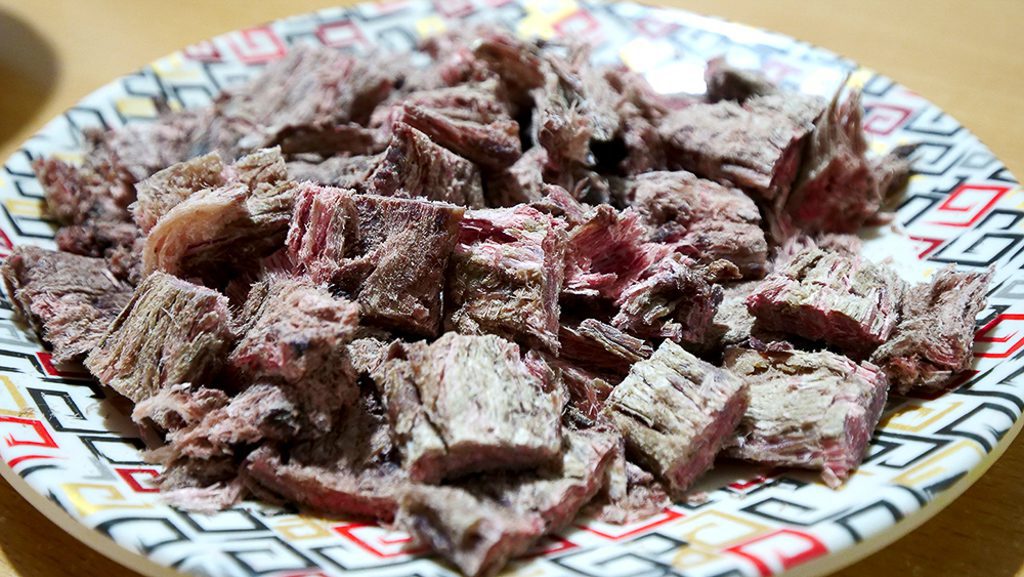
If you’re not a huge fan of spice, beware of their ezay. It’s among the spiciest variations I had in Bhutan. It set my tongue on fire and made my nose run! Try some rice to temper the heat, or better yet, have some ngaja (milk tea) at the ready. The dairy in the milk will help wash some of the heat off your palate. This meal is among the things you must see and do in Thimphu, Bhutan if you can handle the heat!
Typical Bhutanese Restro & Bar
Hong Kong Market opposite Kinley Penjor Milk Booth
Thimphu, Bhutan 11001
Phone: +975 77443959

One of the biggest elements of having a true Bhutanese experience is hiking to monasteries. The hikes can vary in difficulty and length, so be sure to check before you attempt any to make sure you’re in proper shape for it. A good hike for moderately fit travelers is the one to Changangkha Lhakhang. This is a traditional 12th-century Buddhist monastery that stands on a ridge high above central Thimphu.
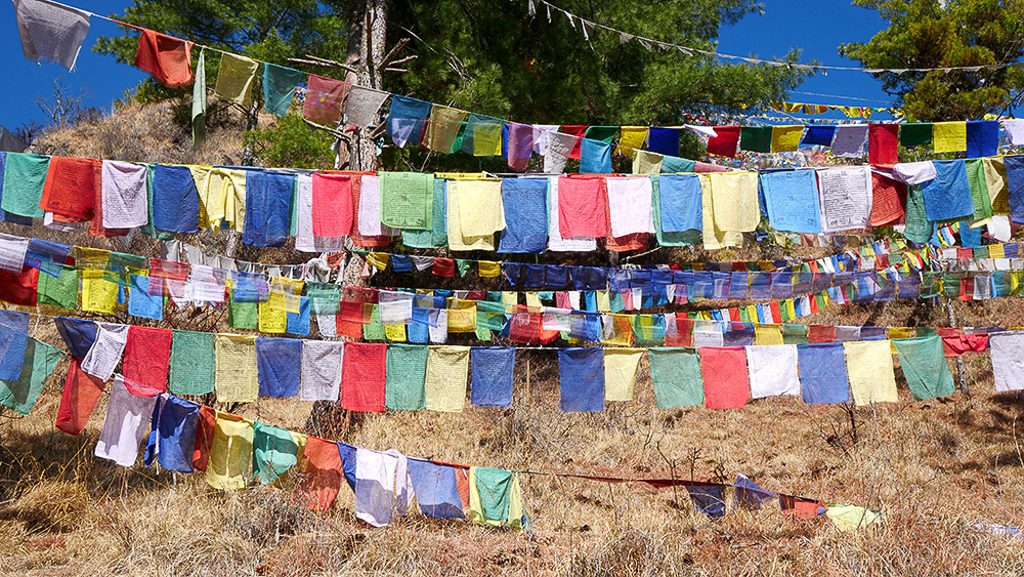
To get there, you must drive to Kuenselphodrang Nature Park near the Buddha Dordenma. From there, you’ll follow a biking and hiking trail through the forest to the monastery. The incline is gradual and a moderately fit person should be able to manage the hike in about 90 minutes or so. Dress appropriately, as it’s warm in the sun, but a lot colder in the forest.
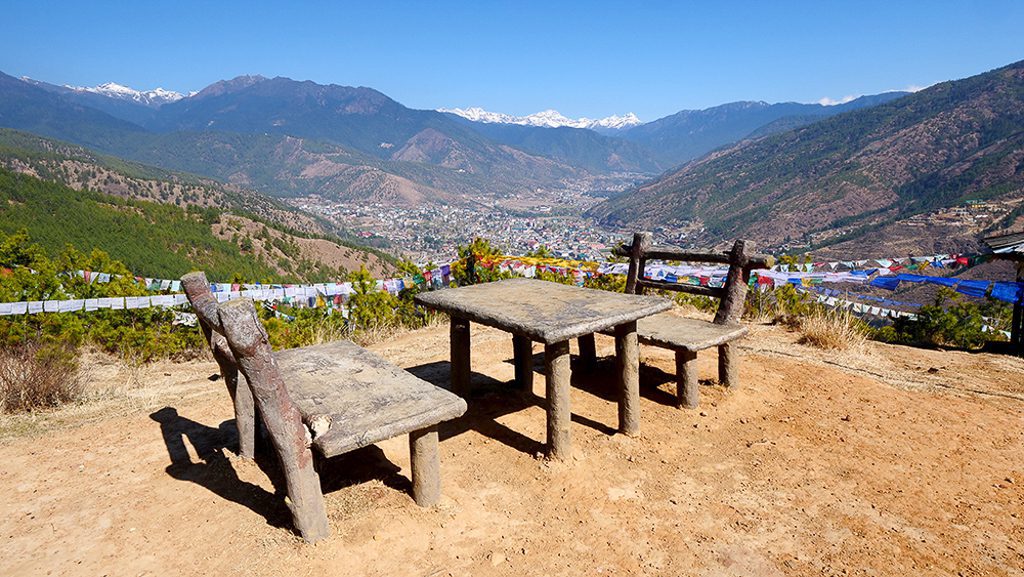
Keep in mind that the gradual incline may still be a bit challenging if you’re slightly out of shape. The trail gets pretty narrow after you cross over a couple of wooden bridges. Because of that, I advise staying as far to the left as you can as you navigate the trail, as there are sheer drops on the right side. It’s not the type of trail I’d ever want to bike on!

As you ascend the mountainside, you’ll pass lots of prayer flags, which are said to bless passersby. The winding forest trail will also take you past lots of rhododendrons and blue pines. You should be able to spot the Buddha Dordenma far behind you and Changangkha Lhakhang ahead of you long before you reach it. Even from far away, the Buddha Dordenma looks massive! There’s also a small picnic area if you brought food and need to take a break to eat.
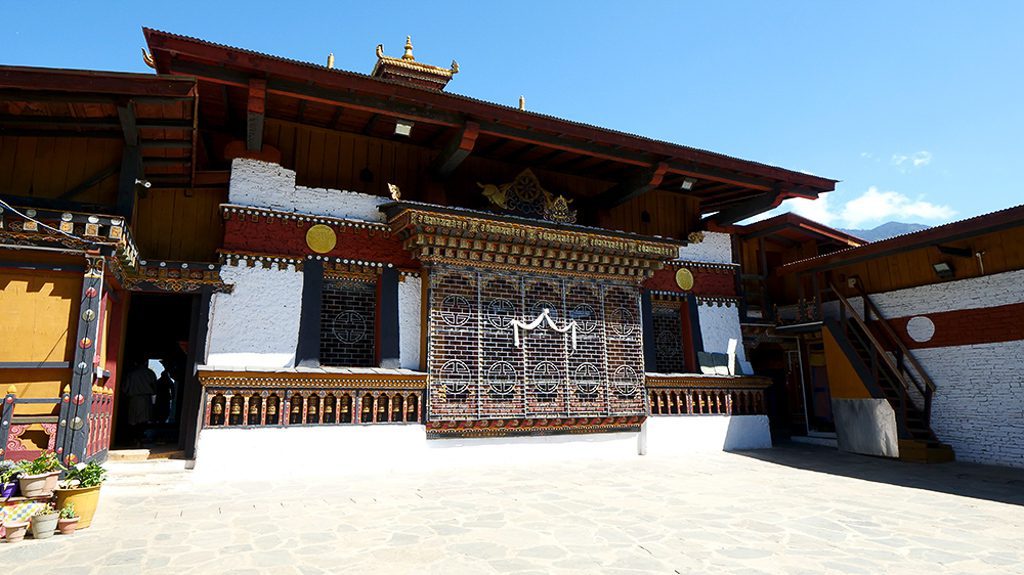
Once you reach the monastery, be sure to remove your hat if you’re wearing one. Changangkha Lhakhang Monastery was built on a site by a Tibetan man named Lama Phajo Drukgom Shigpo. Parents bring their newborns there for them to get names and blessings from Tamdrin, a god of protection.
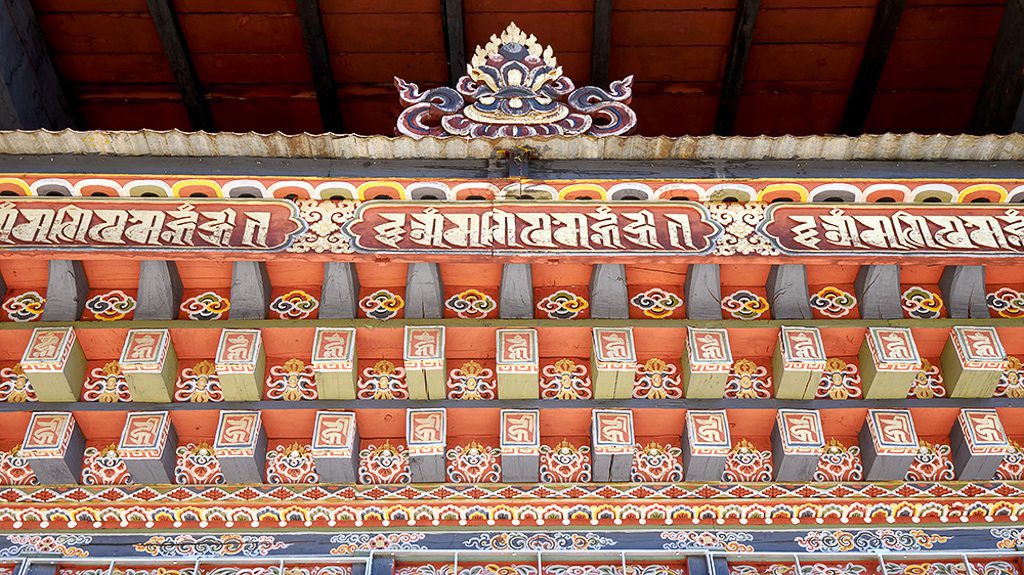
I learned that they don’t really have family names in Bhutan, so the names come from the monastery. The children get blessed by a ritual dagger called a phurba and are then given a piece of sacred thread.
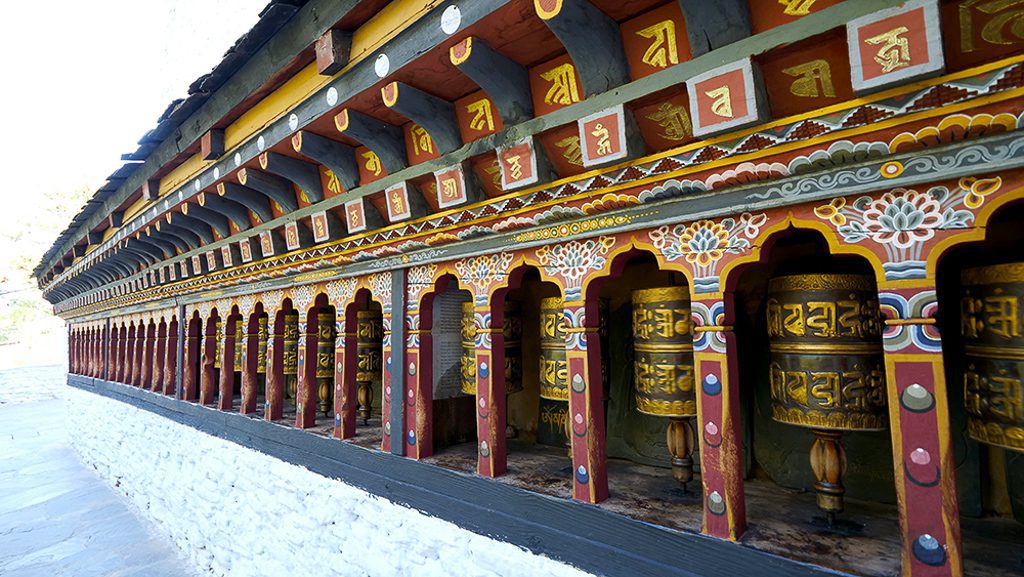
While you’re at the monastery, be sure to check out the interior murals and the shrine dedicated to the mermaid, or tshomen, in the central courtyard. You can also meet with the monastery’s astrologer. After you give him your date of birth, he will refer to divination charts and be able to recommend certain protective prayer flags to you!

Like with all monasteries and temples in Bhutan, you can’t take photos or videos inside. But you’ll be able to witness parents and children filing inside a small room filled with monks and a statue of the god of compassion. Outside, you’ll find 108 prayer wheels and a bright and colorful display that is said to wash away evil spirits.

NOTE: I believe the best way to reach Changangkha Lhakhang Monastery is by taking the 90-minute hike up the mountain. But if you’re not in great shape or are immobile, you can also reach it by car. Whichever way you get there, you will have a great experience at one of the top things to see and do in Thimphu, Bhutan!
Changangkha Lhakhang
Changangkha Lhakhang Footpath
Thimphu, Bhutan

The National Memorial Chhorten, also known as the Memorial Stupa and the Thimphu Chorten, is a stupa built in 1974 to honor Jigme Dorji Wangchuck, the third king of Bhutan. His mother, Her Majesty Gyalyum Ashi Phuntsho Choden Wangchuck, was the main patron. The stupa is called the most visible religious landmark in the country, and with its golden spires and bells, it’s not hard to see why!

The Tibetan-style chorten is large and white with two spires: one atop its roof and another above the front porch. It’s surrounded by green grounds, which include a small garden, cherry blossom trees, a gate with three protective bodhisattvas on it, and ten large, red prayer wheels.
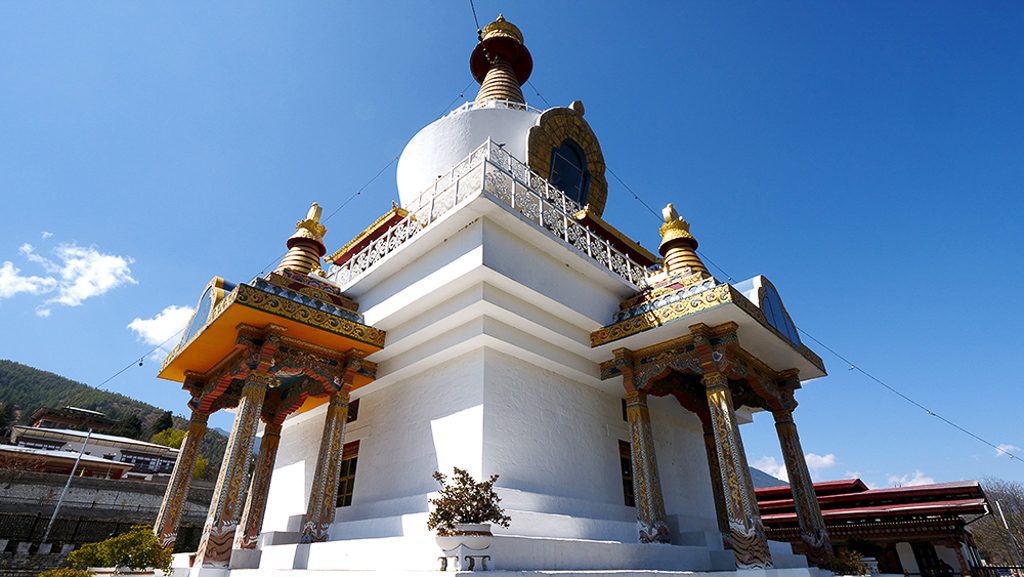
Like all religious structures in Bhutan, you must circle the National Memorial Chorten clockwise while reciting prayers. Mostly older people come there to pray. People who visit the stupa during the Monlam Prayer Festival, held in the first month of the year according to the Tibetan calendar, will be blessed by Bhutan’s religious head, Je Khenpo.
National Memorial Chhorten, Thimphu
Chhoten Lam
Thimphu, Bhutan

Arguably one of the most unique places you can visit in Thimphu is the Cordyceps Tasting House in downtown Thimphu. It’s the only traditional teahouse in the country, and is also part museum. There, you’ll learn that cordyceps are caterpillars that eat a certain fungus, are killed by it, and then bloom into a mushroom.
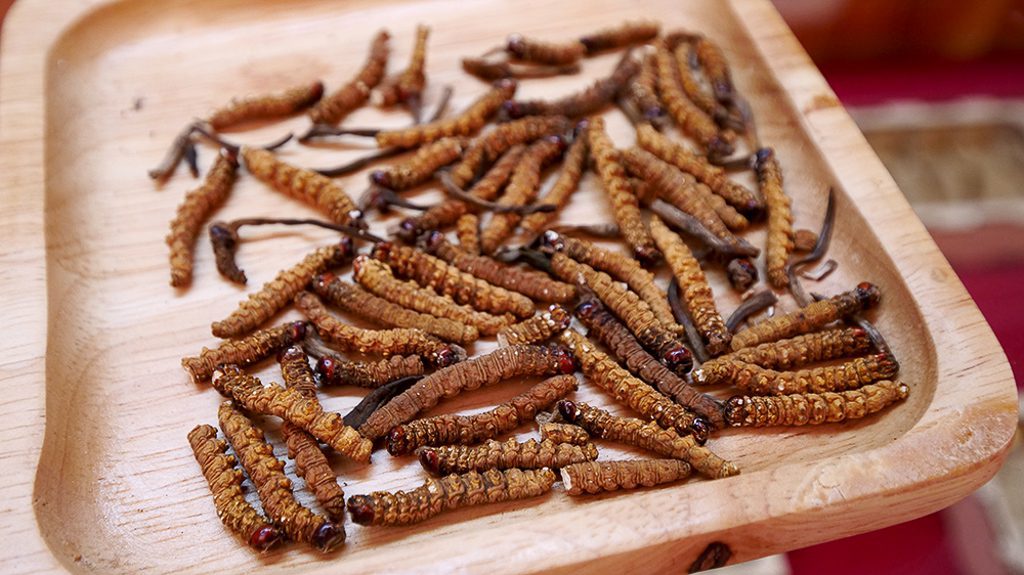
To many, cordyceps may not sound very appetizing, but here, you can try several drinks and dishes infused with them. The cordyceps, found in the high ranges of the Himalayas, are so difficult to procure that they’re sometimes referred to as Mountain Gold!
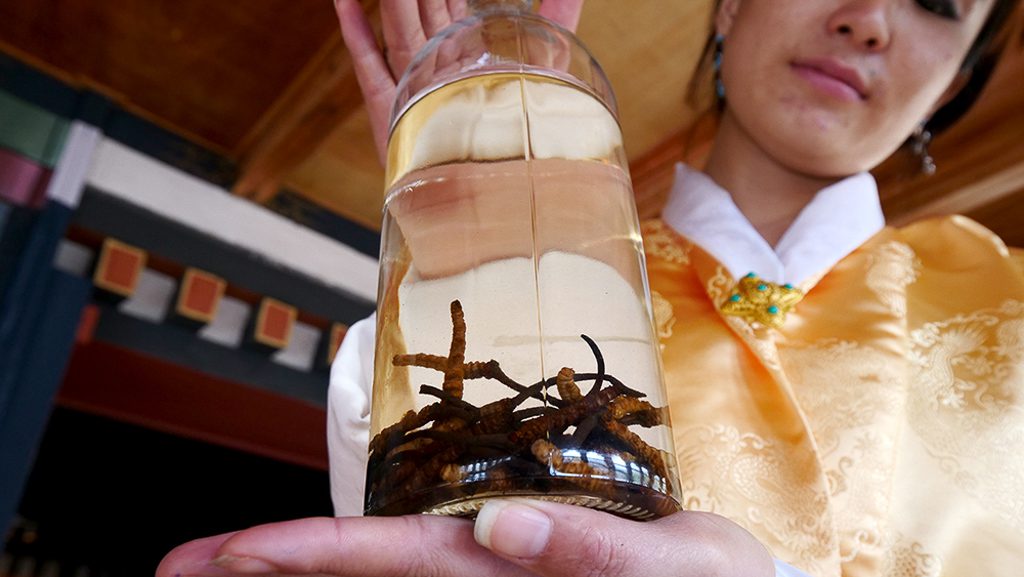
I recommend trying a mini shot of cordyceps-infused ara. It’s very strong and not as smooth as other ara varieties I’d had in the country. I learned that the cordyceps itself is what makes it so potent!
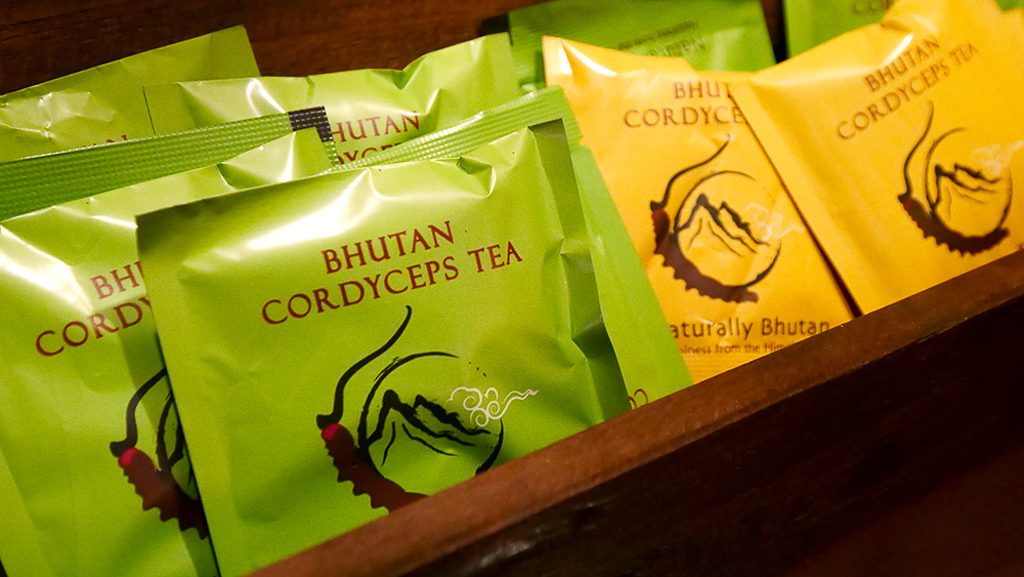
You can also try some teas infused with codyceps, along with K5 whiskey. The cordyceps-infused whiskey was smoother than the ara. If you have time, grab a cordyceps-infused meal at the on-site restaurant. And if you’d like to take some home with you, you can buy cordyceps tea and small vials of their ara. It makes for a one-of-a-kind souvenir you can’t get anywhere else!
Cordyceps Tasting House
Kashi Lam
Thimphu, Bhutan
Phone: +975 17 53 10 99
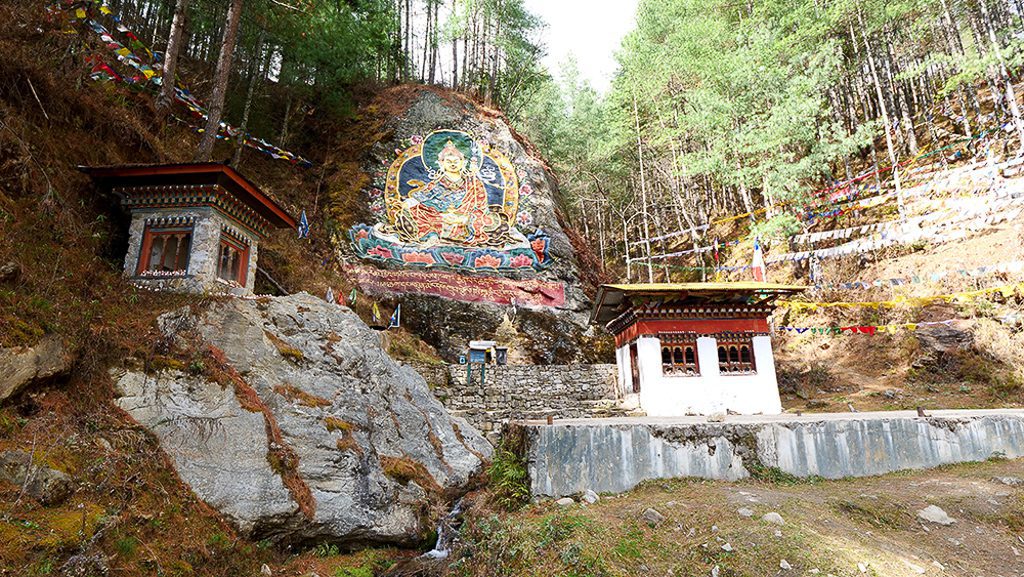
I hiked to several monasteries in western Bhutan during my eight days in the country in March of 2020, but one of the most memorable was the hike I took to Chagri Dorjeden Monastery. Getting there is a short day trip, as you’ll have to drive north, through the mountain forests of Jigme Dorji National Park, also known as the Valley of the Tigers. You’ll also pass a university for monks on the way. Past the university, you’ll see a mountain with a massive, village-like monastery clinging high up its side.

The monastery was built by the unifier, Ugawang Namgyal, in 1620 and was the first built in Bhutan. The area is beautiful and peaceful but quite chilly because of the elevation. Because of the cold weather, I advise wearing a wool sweater, and you’ll also need good hiking boots because the hike is pretty intense. It also goes without saying that you need to be in moderate to good shape to attempt this hike!

As you begin your hike, you’ll cross a wooden bridge and pass a temple with 108 prayer wheels. The hike only takes 45 to 60 minutes, but it’s an intense trek up a steep, rocky path. At some points, the path is almost vertical, so it’s like following a rock staircase. The midway point is marked by a stupa. Stop there to catch your breath if you need to before continuing on.

As you get closer to the monastery, you’ll likely start noticing different species of goats around. I came across a cute baby goat and some different mountain goats as I approached.

When I visited Chagri Dorjeden Monastery, it was under renovation, so there was lots of construction going on. But I was still able to explore freely with my guide Tsheten. You can see a small meditation house where monks who have completed nine years of higher studies meditate for three years, three months, three weeks, and three days.
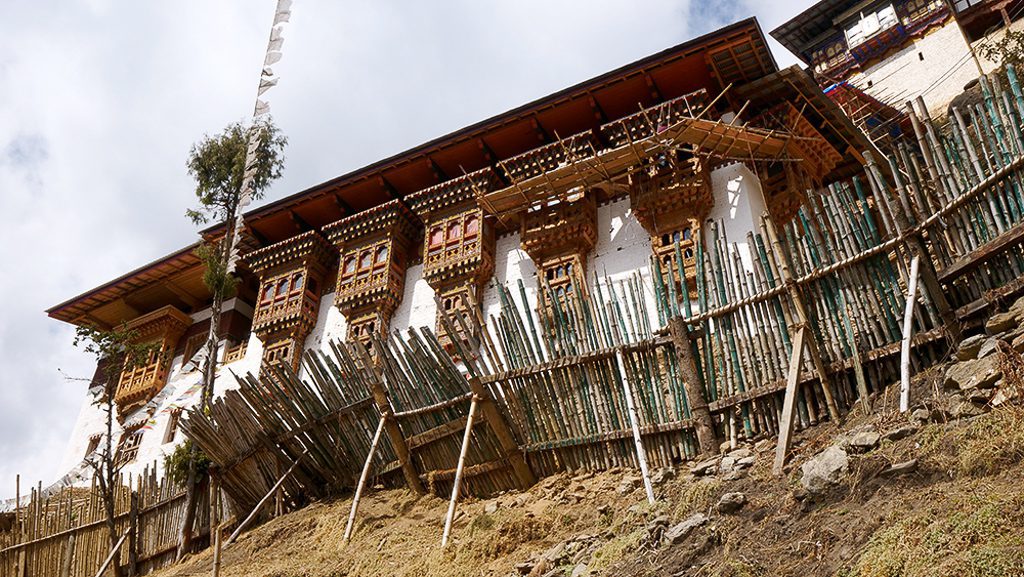
As usual, you cannot film in the temple, but from the monastery, you can enjoy breathtaking views of the surrounding Thimphu valley. It’s a fantastic spot to take photos. Further along are the dormitories for the monks and 108 prayer wheels. There’s a rocky staircase leading up to the top of the monastery, but refrain from speaking here, as you don’t want to disturb monks who may be meditating nearby.

At the top of the monastery, you can see the roof of the meditation hut and its golden tower, as well as the building where Ngawang Namgyal himself meditated for over three years. Enjoy the stunning views of the valley, river, and the university for the monks far below. This view is your reward for making the intense hike and is one of the top things to see and do in Thimphu city.
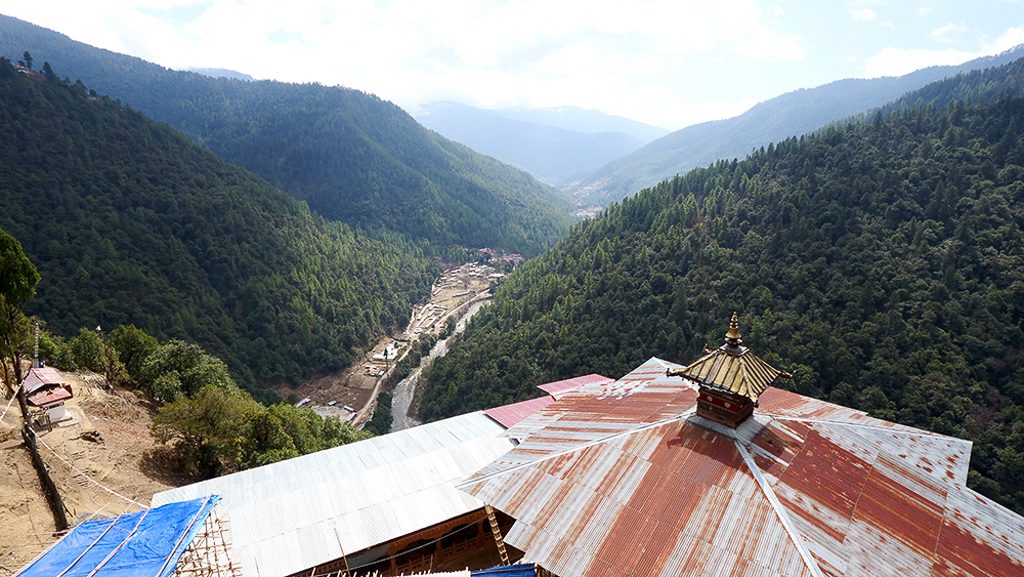
From there, you can begin to make your way back down. You can go back the way you came, or you can take a dirt staircase down that will have you back down the mountain in just fifteen minutes!
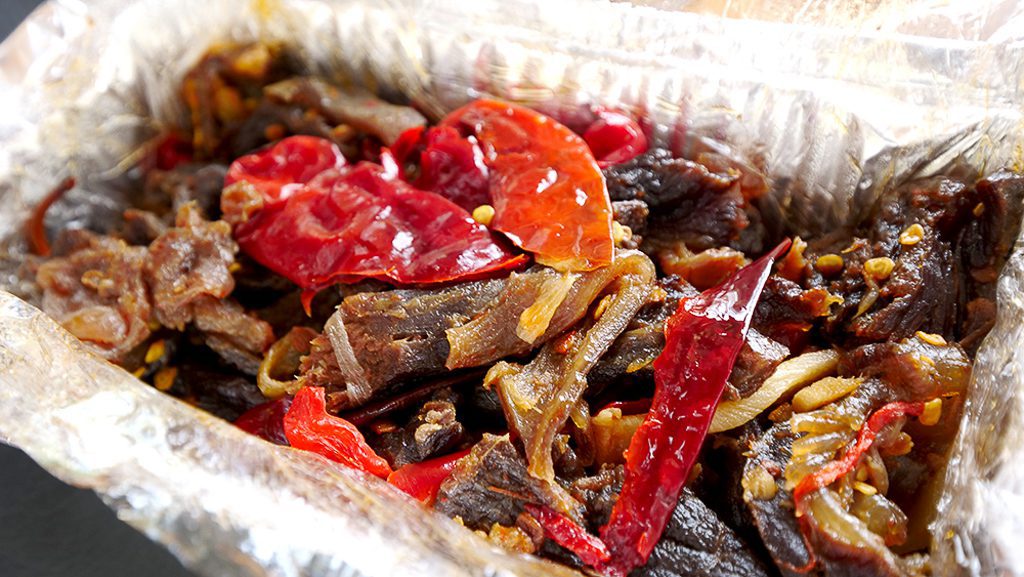
Bhutan is such a picturesque country with so many rivers criss-crossing it that it would be a crime to not have a riverside picnic while you’re there. After my hike up to Chagri Dorjeden Monastery, my guide and I drove three minutes to a nearby river. There, we found a stupa and a covered picnic area near a stupa surrounded by prayer flags.
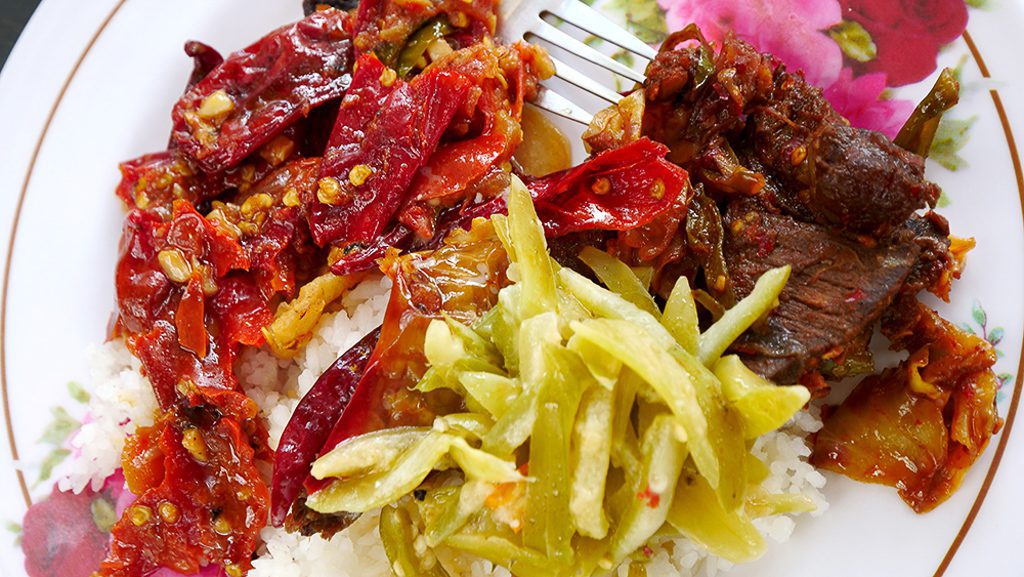
It was there that we enjoyed a picnic of food we had bought earlier in the morning at Typical Bhutanese Restro & Bar. I enjoyed some light but creamy beans, some jerky-like dried beef, and some ultra-tender beef with chilies. We also brought along rice, cabbage, and some ema dashti with turnip that had a heat that snuck up on me. Every dish was fresh and tasty, and it was yet another example of how much Bhutanese dishes can vary depending on who makes them.
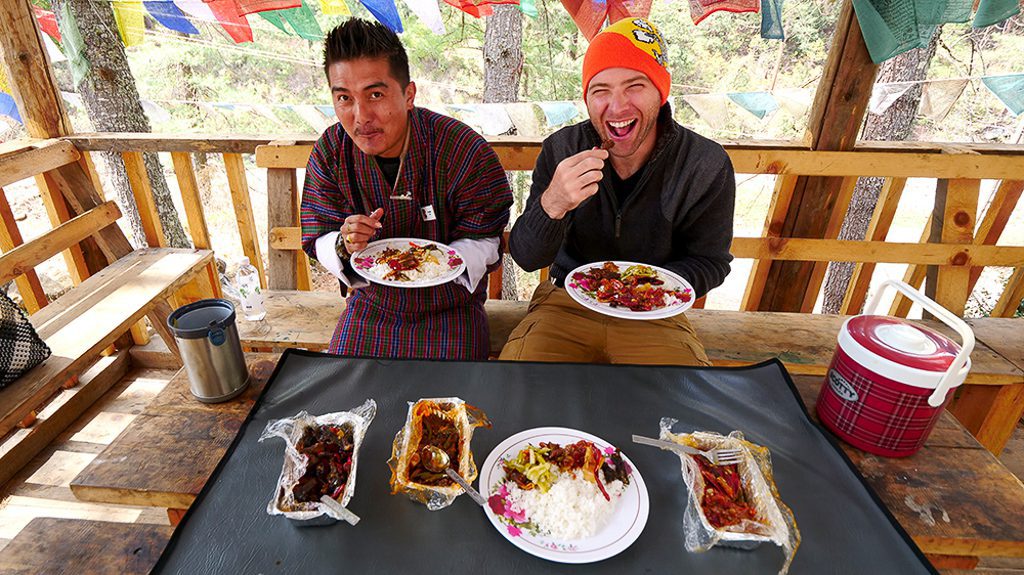
There are lots of great, meaty dishes in Bhutan, but in all honesty, the highlight of nearly every meal in the country was the vegetables. This meal was no exception, although the dried beef with red chilies was also mouthwateringly good!
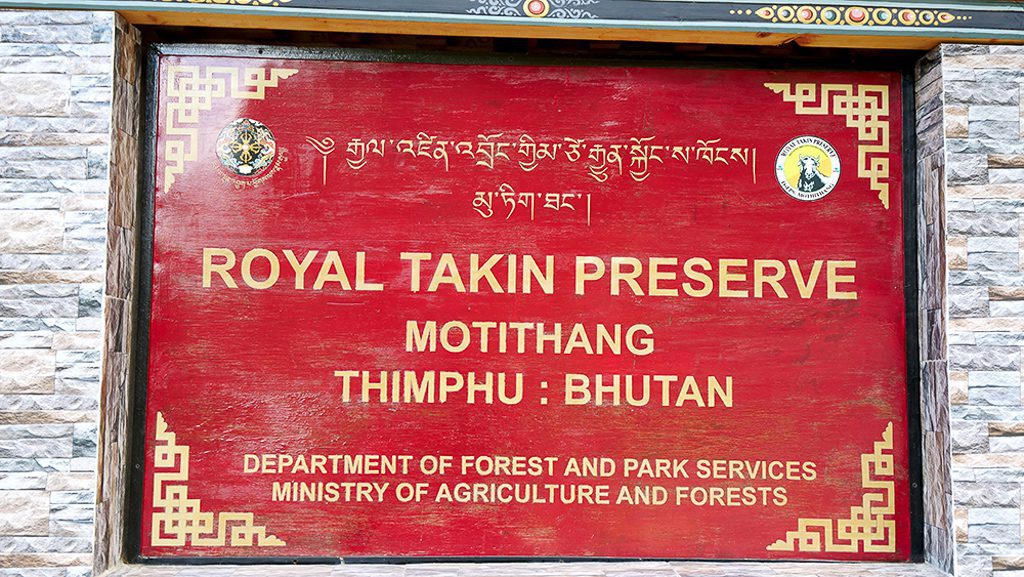
If you’re an animal lover like me, one of the top thing you must see and do in Thimphu, Bhutan is visit the Royal Takin Preserve. Also known as the Motithang Takin Preserve, this eight-acre wildlife reserve was once a mini-zoo. It’s home to Bhutan’s national animal, the takin, a bizarre-looking creature that also lives in parts of China and Myanmar.
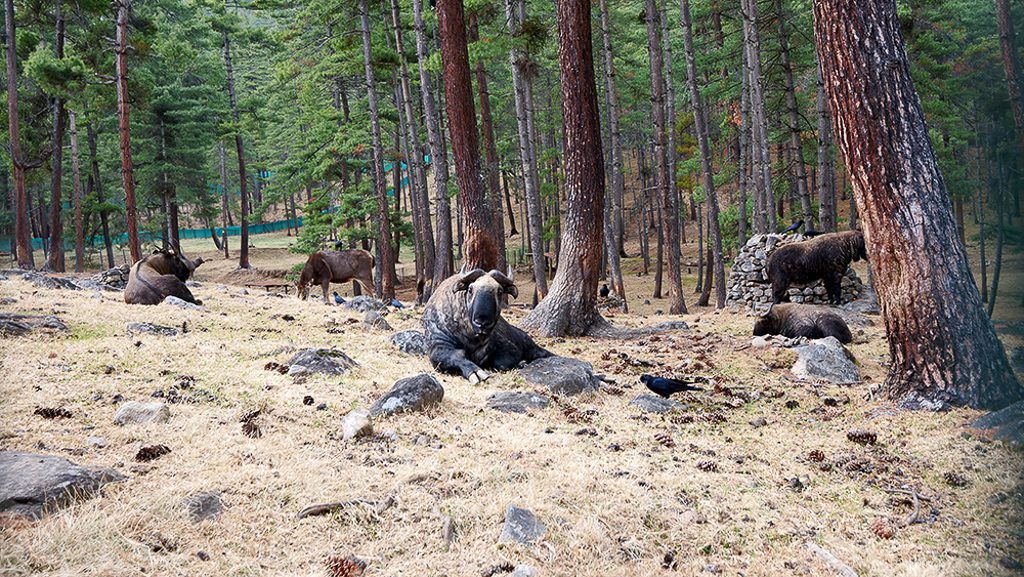
Takins are large mammals with brown or yellow hair, stocky legs, and hooves. Their bodies are similar to those of cows, but they have heads more like a goat, complete with horns. The horns on both sexes can grow up to 25-30 centimeters. I had never seen anything like them before! According to a legend dating back to the 15th century, the takin was a creation of the Divine Madman, Drukpa Kunley.
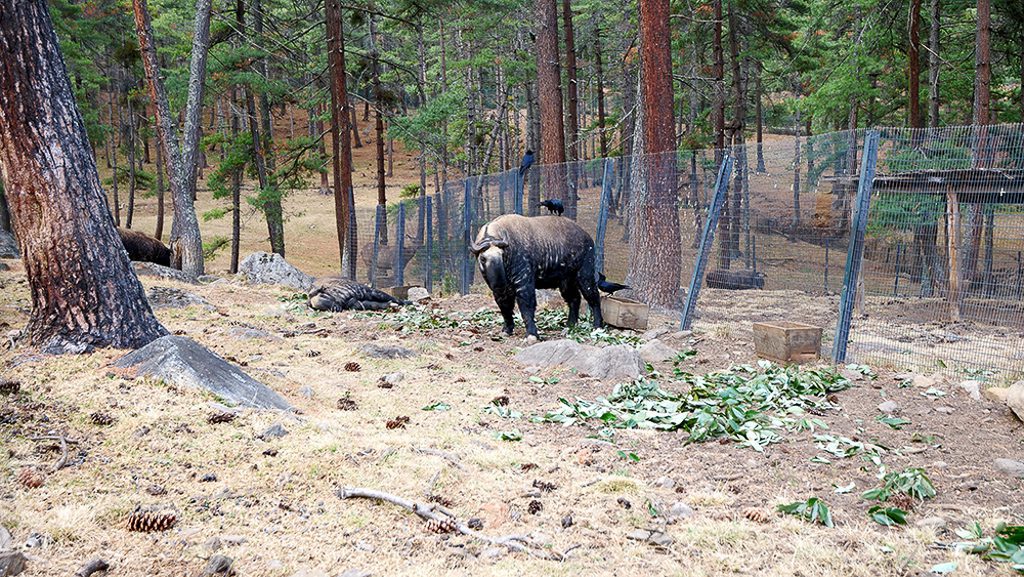
The tale states that the Bhutanese people asked him for a miracle. He agreed if they would feed him a whole cow and a whole goat. He devoured both and laid out their bones, placing the skull of the goat on the cow skeleton. After he said a spell, the animal sprang to life and went to graze in a nearby meadow. According to the story, the takin has been common in Bhutan ever since.
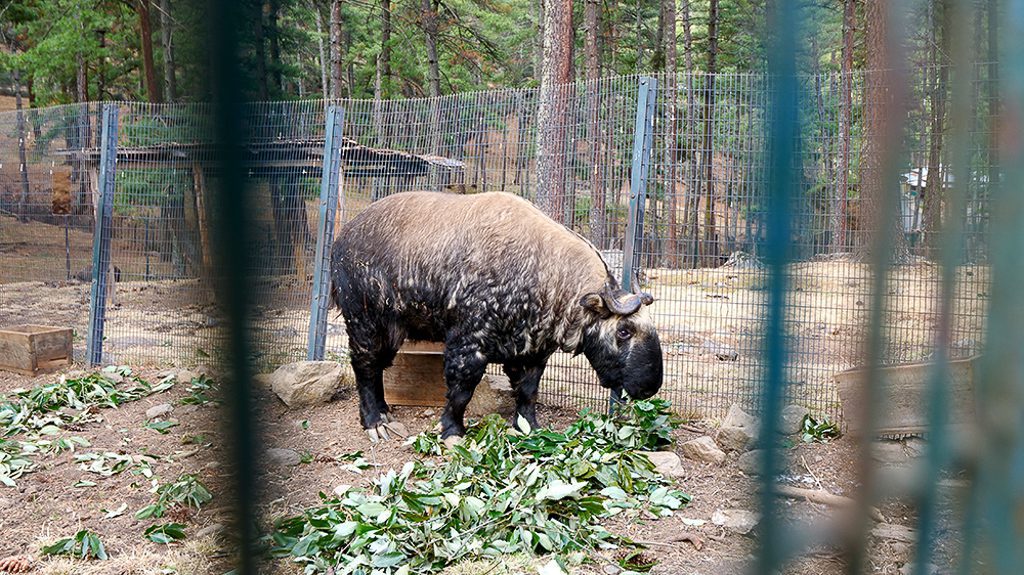
The preserve came about after several takins had been kept in a mini-zoo. The king of Bhutan, who believed it wasn’t moral for a Buddhist country to hold the animals in captivity, ordered their release. But the docile takins stayed in the area after the zoo’s closure. The decision was then made to keep the takins in an enclosed forest habitat in the Motithang neighborhood.
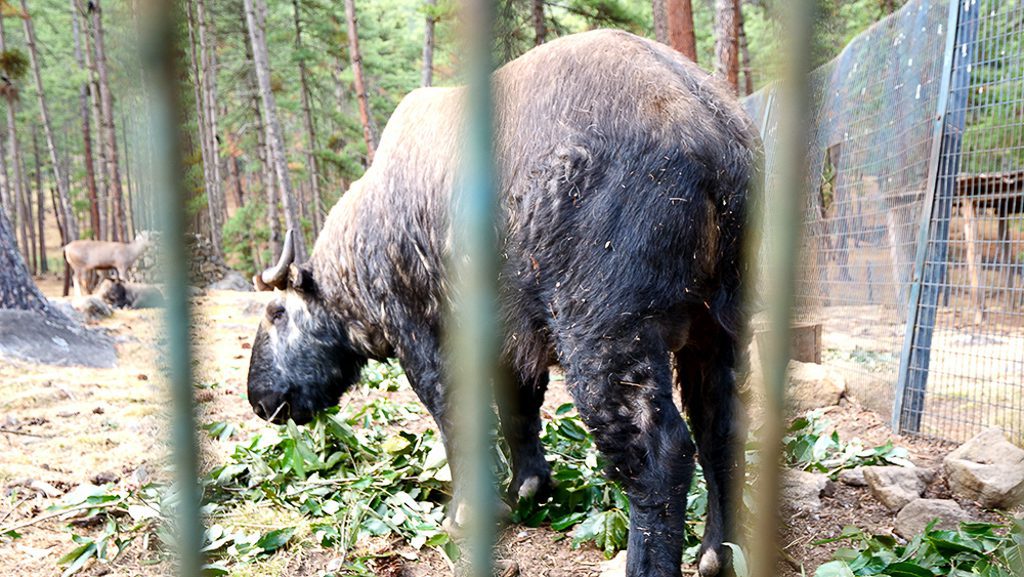
In addition to the resident takins, the Royal Takin Preserve is also home to many different bird species, as well as mountain goats and deer. When you visit, you may notice some animals with injuries. This is because the preserve also serves as a wildlife rehabilitation center. If you love wildlife, this is the place for you!
Hours: Tuesday through Sunday, 9 a.m. to 4 p.m.
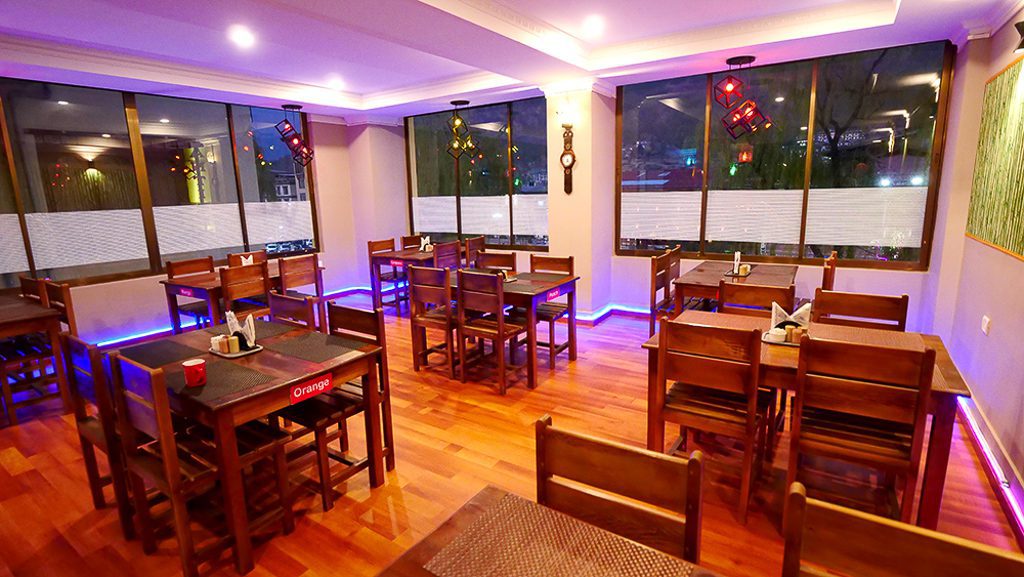
Because Thimphu is such a compact city, nearly every point of interest is located within minutes of each other. That includes restaurants like Thakali Kitchen, which is just a two-minute walk from the Pedling Hotel & Spa. There, for a nice change of pace, you can get a taste of Nepali food!
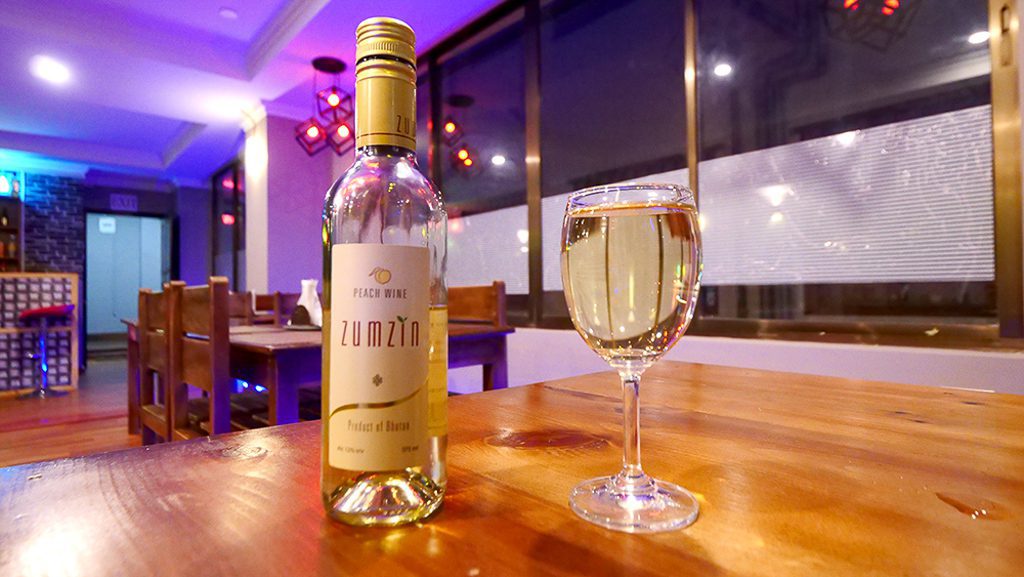
Finding Thakali Kitchen is the challenging part, as you have to head down a tight alley, down a flight of stairs, and into a second alley to get there. But once you find it, you’ll feel instantly relaxed in the cozy, welcoming dining area, which is very vibrant and reminiscent of India and images I’d seen of Nepal.
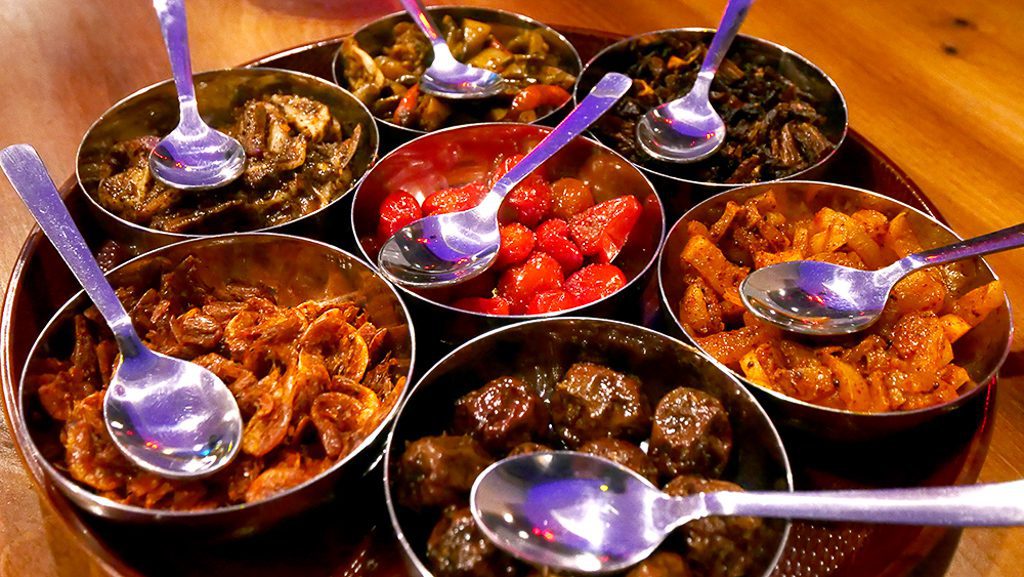
The chef recommended their Special Thakali Thali, which is a massive buffalo thali. It contains less masalas than a typical Indian thali and has almost no desserts. The appetizers consist of pickled radish, prawn fry, dried spinach, wild fruit, round chilies, and mixed pickle with chilies and tomatoes. The thali itself consists of fatty and gamy buffalo meat, rice, vegetables, a crunchy flatbread called papad, yogurt, and an earthy and creamy black lentil soup.
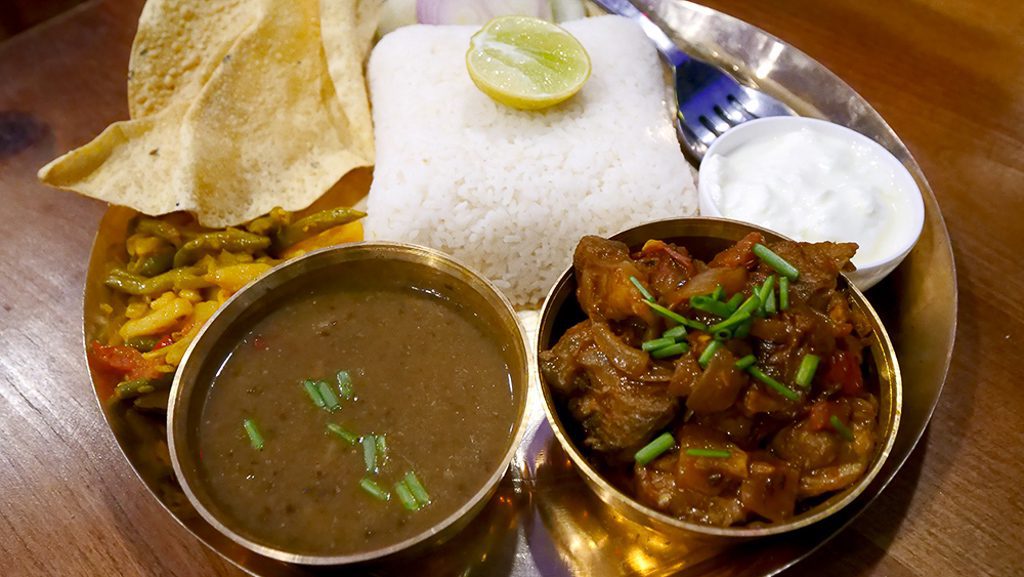
The buffalo meat was more tender than beef and practically melted in my mouth. I loved the curry on it, as well as the amount of spice in the crunchy prawn curry. They were hot for sure but not unbearable. You also can’t go wrong with the pickled vegetables, spinach, or the lentil soup. The round chilies are also quite hot, but the fire in your mouth dies down almost immediately. My favorite item was the radish, which was like a crunchy but creamy water vegetable. After you try everything individually, scoop it all up with the papad like a big, edible spoon!

Enjoy your thali with some Zumzin peach wine, which tastes like a sweet white wine. It’s very tasty and tastes like straight peaches! It’s the perfect drink to enjoy with such a rich, fatty, and earthy meal. If you want to experience all the things you must see and do in Thimphu, Bhutan, you can’t miss this meal!

There’s only one main highway in Bhutan. It runs from west to east and connects all of the country’s major cities, including Paro, Thimphu, and Punakha. Along the winding, four-lane expressway between Thimphu and Punakha, you’ll come across one of Bhutan’s most famous attractions, the Druk Wangyal Khang Zhang Chortens.
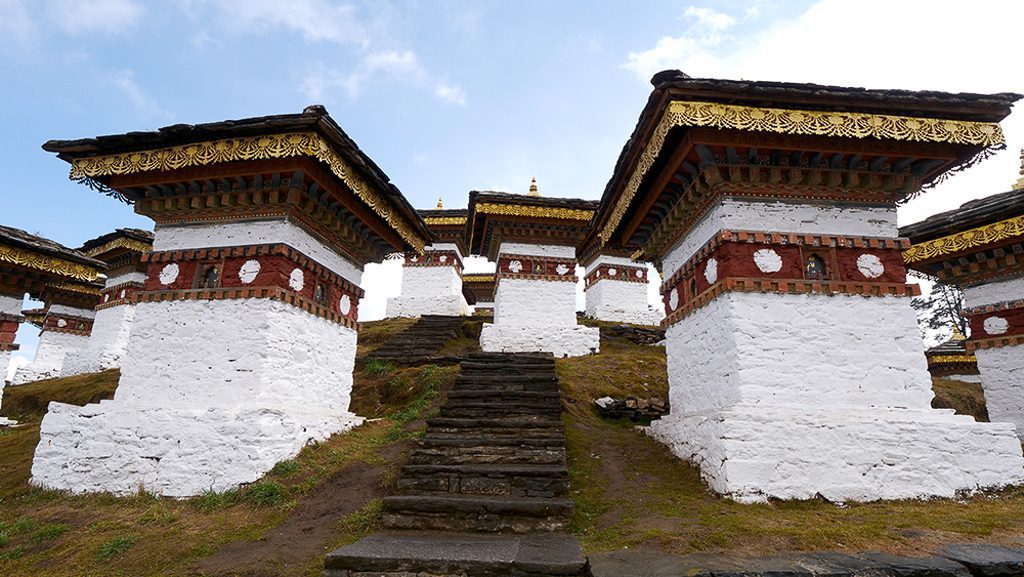
This memorial is located in Dochula Pass, a mountain pass roughly 10,200 feet above sea level. It consists of 108 stupas on a hillside, which were built in 2004 to honor Bhutanese soldiers who died the previous year while fighting Assamese insurgents from India.

At the top of the hill is the largest stupa, while the 107 smaller ones are scattered around the hillside. Each of them has script written on their exteriors as well as an idol of the Buddha inside.
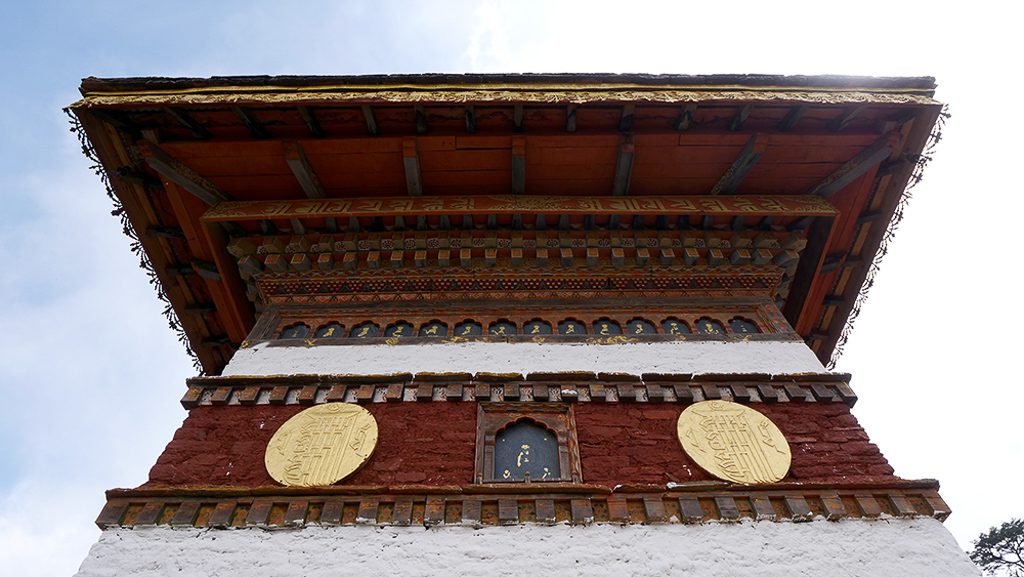
On the day I visited, it was gray and overcast, so I didn’t have the best view. But I was told that on clear days, the Himalayan mountains make for a gorgeous backdrop for the stupas. Even without the view of the mountains, visiting the Druk Wangyal Khang Zhang Chortens was a memorable experience and one of the many things you must see and do near Thimphu when you visit Bhutan!
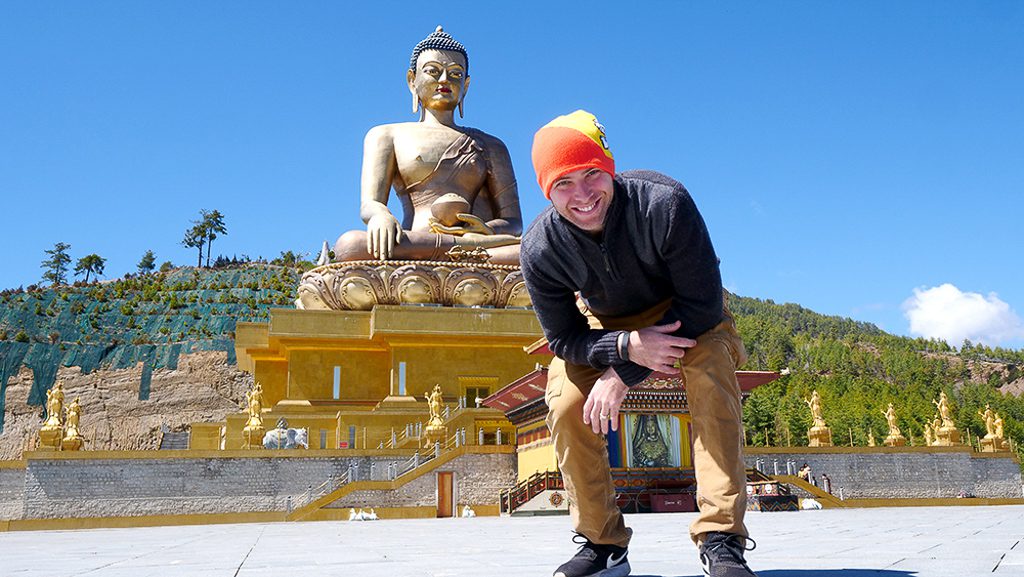
Each Bhutanese city I visited on my eight-day road trip through the country was different from the last. That said, they all still exuded the same peaceful, friendly, happy charm I came to associate with Bhutan. Of all the cities I visited, Thimphu offered the most variety as the capital and largest city. From the stellar food options to the monasteries to the various bhutanese culture and recreational sites, my days in Thimphu were packed from sunup to sundown. They were some of my favorite days of my trip and I’m sure you’ll enjoy your time there as well. Book a trip to Bhutan today to experience everything Thimphu has to offer for yourself!
Huge thanks to my friends Tsheten and Nidup from MyBhutan for showing me around their beautiful country!
NOTE: If you need to check the visa requirements of a particular country, click here. To apply for a visa, find up-to-date visa information for different countries, and calculate the cost of a particular visa, click here!
Counter
101 Countries • 1432 Cities